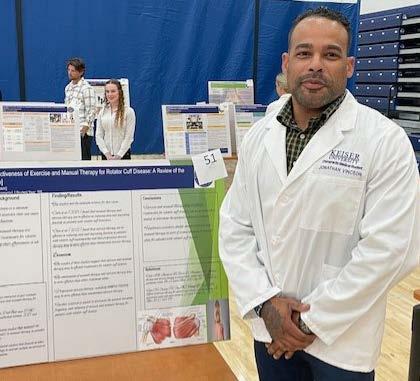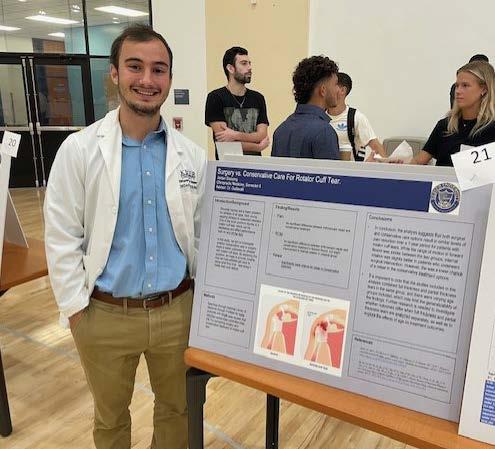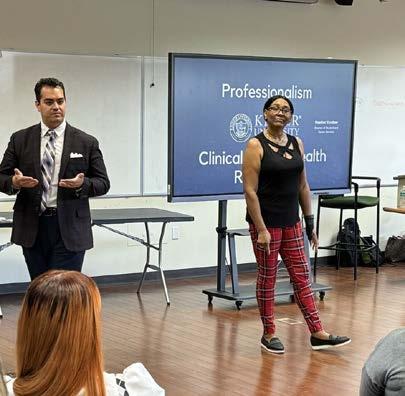







Seahawk Graduate School Newsletter Vol 2 HAPPIER NOT JUST HAPPY .................. 37 .............. 24 HOLISTIC WELLNESS
Perspectives ........................... 45
The Impact of Stress on Physical Health: Psychological


37 STORIES OF SuccessAlumni PERSONAL 20 A brief welcome note from Dr. Robert Keiser .................. 1 Facts about Keiser University .............................................. .3 Accreditation 5 Keiser Seahawk Success.......................................................... 5 Campuses...................................................................................... 5 Rankings and awards ................................................................ 6 Graduate School Introduction Statement 8 Graduate faculty profiles and their contributions to the field..................................................................................... 9 FDLRS Grant Information and Multidisciplinary Center (KUMDC) ..................................................................... 12 Research Committee Annual Report 2023 ................... 16 Nurturing Holistic Wellness: A Journey Towards Physical, Mental, and Social Health.................................................... 24 Empathy and Self-Care with Graduate Students ...... 28 The “Evolution” of Mental Health: A Dilemma of Access and Professional Ethics ........................................................ 32 The Interaction Between Professors and Students in Virtual Environments: A Fundamental Bridge to Mitigate Academic Stress 34 Go Ahead, Really -- Applaud Your Triumphs Students ...................................................................................................... 40 The Neuroscience of Stress and Its Impact on Physical Health 43 The Physical Consequences of Stress ............................ 45 Breaking Language Barriers: Improving Access to Health Services for Spanish-Speaking Latinos in the United States 53 Statewide Graduation 2023 ............................................... 55 Graduate Nursing Residency ............................................. 57 Clinical Mental Health Residency ..................................... 58 Keiser University Day at the Capitol 59 A brief note of appreciation to readers.......................... 91 Support Keiser University’s Mission ................................ 93 Not Just Be Happier, Happy


Palabras de bienvenida Norma Pastor, Decana Académica.................................................................... 61 Promoviendo el bienestar integral: Un viaje hacia la salud física, mental y social ....................................................... 62 Empatía y autocuidado con estudiantes de posgrado ... .......................................................................................................... 66 La “evolución” de la salud mental: Un dilema de acceso y ética profesional 69 La interacción entre profesores y estudiantes en entornos virtuales: Un puente fundamental para mitigar el estrés académico ...................................................................... .71 Sé Más Feliz, No Solo Feliz .................................................... 72 Adelante, de verdad -- celebra tus éxitos, ¡estudiante! .......................................................................................................... 76 La neurociencia del estrés y su impacto en la salud física ............................................................................................... 79 Las consecuencias físicas del estrés 81 Rompiendo las barreras del idioma: Mejorando el acceso a servicios de salud para los latinos de habla hispana en los Estados Unidos ............................................................. 88 Latin Division

RANKED #1 UNIVERSITY IN SOCIAL MOBILITY
U.S. NEWS & WORLD REPORT BEST COLLEGES 2022-2023
Start building the life you’ve always wanted at Keiser University. Committed to a “students first” philosophy, we prepare graduates for a wide range of careers in fields like business, criminal justice, health care, and technology.
21 CAMPUS LOCATIONS THROUGHOUT FLORIDA, INCLUDING ON-CAMPUS HOUSING AT OUR FLAGSHIP RESIDENTIAL CAMPUS
A DIVERSE STUDENT BODY REPRESENTING MORE THAN 60 COUNTRIES
A WINNING TRADITION WITH 29 ATHLETIC TEAMS AND CLUB SPORTS
RANKED #4 IN NICHE 2023 SAFEST COLLEGE CAMPUSES IN FLORIDA

IEP - ASSOCIATE – BACHELOR’S – MASTER’S – DOCTORAL
JOIN THE SEAHAWK NATION
KeiserUniversity.edu/international-students


Dear Graduate School Community,
with great pleasure, I extend my warmest greetings to all of you in this edition of Keiser University’s Graduate School newsletter. As we find ourselves amid another academic year, I am filled with immense pride and excitement for what lies ahead.
First and foremost, I want to congratulate our dedicated faculty and staff for their unwavering commitment to excellence in teaching, research, and mentorship. Your passion and dedication inspire our students to reach for the highest levels of achievement and professionalism, and I am constantly amazed by the groundbreaking work that takes place within our institution.

“You have chosen a path that demands perseverance, intellectual rigor, and innovation”
To our extraordinary students, both current and incoming, your journey through graduate studies is a testament to your determination and pursuit of knowledge. You have chosen a path that demands perseverance, intellectual rigor, and innovation, and I have no doubt that you will rise to meet these challenges with remarkable success. Your pre-
1
sence enriches our academic community, and I eagerly anticipate your contributions to your respective fields.
I also want to recognize the achievements of our alumni, who continue to make significant impacts in their professions and communities worldwide. Your accomplishments reflect the quality education you received here, and we take immense pride in your successes. I encourage you to stay connected with our graduate school and to continue sharing your stories of achievement and inspiration.
As we embark on this academic year, our institution remains committed to upskilling students to compete in a multicultural workforce and to contribute to an ever-changing scholarly community. We at Keiser University understand that every student is a valuable member of our institutional family who if nurtured has the propensity to become leaders and sparks of change in their respective fields.
I would like to extend my heartfelt thanks to our supporters, donors, and partners who play a vital role in advancing our mission. Your generosity and collaboration enable us to offer our students and faculty scholarships, research opportunities, and cutting-edge resources.
In closing, I want to express my gratitude for the collective effort that makes the Graduate School a vibrant and thriving academic community. Together, we have the power to shape the future through education and research, and I am excited to witness the continued growth and achievements of our students, faculty, and alumni.
I encourage you all to stay connected with Keiser University’s Graduate School, engage in meaningful collaborations, and seize every opportunity to learn and grow. The journey ahead is filled with promise, and I am confident that together, we will continue to reach new heights of excellence.
Warm regards,
Robert M. Keiser, Ph.D. M.B.A. Vice-Chancellor of the Graduate School

2





Facts about Keiser University
1
2
Founded in 1977, Keiser University is Florida's second largest independent private, not-for-profit university serving more than 20,000 students earning doctorates, masters, bachelors, and associate degrees in more than 90 career fields.
Keiser University Offers Day, Evening or Online Classes to Accommodate Your Schedule.
3
Over the past 46 years, Keiser University has become Florida’s largest private, not-for-profit university serving approximately 20,000 students, 3,800 employees, and more than 66,000 alumni.
Keiser University has a campus in 21 of Florida’s major and mid-sized metropolitan areas/Florida communities.


5 6
7
8 9
At Keiser University, students are pursuing degrees in over 100 doctoral, specialist, master’s, bachelor’s, and associate fields.
The University’s campuses provide an annual statewide economic impact of over $3 billion and directly and indirectly impact over 30,000 Florida jobs.
Keiser University ranked No. 1 in the country in Social Mobility by U.S. News & World Report in 2023.
In the last two years, nearly $76 million in scholarship funds were awarded to academic and needs-based students. The University is committed to educating and developing leaders to serve and compete globally.
The University is internationally located beyond America’s borders with regionally accredited off-campus sites in San Marcos, Nicaragua and Shanghai, China, and learning centers in Moldova, Taiwan, and Seoul. 3 4
4

Accreditation
Keiser University is accredited by the Southern Association of Colleges and Schools Commission on Colleges to award certificates and degrees at the associate, baccalaureate, masters, specialist, and doctoral levels.
Questions about the accreditation of Keiser University may be directed in writing to the Southern Association of Colleges and Schools Commission on Colleges at 1866 Southern Lane, Decatur, Georgia 30033-4097, by calling (404) 679-4500, or by using information available on SACSCOC’s website: (www.sacscoc.org).
Keiser Seahawk Success
• 18 National championships
• 57 regular season championships
• 55 Tournament championships
• 4 Sun commissioner’s cup champs
• 1 learfield directors’ cup champ
Campuses
The University Comprises 18 Florida Campus locations, an International Division, The Graduate School, a College of Golf and Sports Management, an Online Division, and off-site campus in China, and Nicaragua.
Campuses
5
AND RANKINGS AWARDS SINCE 2020
2021
No. 11 Top Performers Award for Leading Change Blackboard Catalyst
in Social Mobility by U.S News and World Reports (2020-21)
No. 7 for 4-Year Graduation Rates

(Among private, nonresidential campuses) (Chronicle of Higher Ed)
2022
No. 5 Top Performer
in Social Mobility by US News and World Report (2021-22)
Institution by Niche
Top 110
Most Financially Sustainable Universities (Forbes)
No. 34 Top Performers
in Social Mobility by U.S News and World Reports (2019-20)
Florida by Money Magazine
No. 8 Best University in 2020 BlackBoard Catalyst Award 2020
'
No. 2 for 4-Year for Student Success Catalyst Award
Graduation Rates (among private, nonresidential campuses) (Chronicle of Higher Ed)
No. 29 Best Hispanic-Serving for Assessment and Institutional Effectiveness Catalyst Award
No. 1 in enrollment
private, nonprofit universities (Florida Trend)
6
No. 1 Top Performer
2023 in Social Mobility by US News and World Report (2022-23)
No. 29 Best Hispanic-Serving in Florida (2022-23 Niche)
Institution by Niche (2022 - 23)
No. 4 Best Online 2024
Master’s Degree in Psychology (Fortune Magazine)
No. 3 in Forbes’ Best Online Ph.D.s in Organizational Psychology Programs of 2024
No. 2 Best Online Ph.D.s in Educational Leadership Of 2024 by Forbes
in Social Mobility by US News and World Report (2023-24)
No. 8 Best Online
Master’s Degree in Accounting (Fortune)
No. 14 Best Colleges and Institutional Effectiveness Catalyst Award for Assessment for Student Succes Catalyst Award
No. 1 in enrollment
Private, nonprofit universities (Florida Trend)

No. 21 Top Performer Colleges in Florida (Niche 2023-24)
No. 11 Best Colleges
No. 10 Top private for Nursing in Florida (Niche 2023-24)
No. 23 Best Colleges in Florida (niche 2023-24) Institutions (Niche 2023-24)
No. 85 Best Hispanic-Serving and Universities for Hispanics (Hispanic Outlook on Education 2023-24)
No. 100 Colleges
No. 100 Colleges and Universities for Hispanics (Hispanic Outlook on Education 2023-24)
7
Graduate School Introduction Statement
The Graduate School strives to upskill its global and multicultural student population to be leaders in the workforce, research, and scholarship. Keiser University’s Graduate School offers programs in three different languages – English, Mandarin, and Spanish to serve its global and diverse population. The program portfolio is focused on providing pathways to occupational leadership, growth in research and scholarship, and providing students with the best return on their educational investment. The Graduate School’s faculty mirror this commitment and are prepared and actively engaged in the career fields they teach and are often research leaders in their respective fields.

8
Graduate faculty profiles and their CONTRIBUTIONS TO THE FIELD
 Graduate School
Graduate School

Dr. Keintz is the Graduate Dean for health-related programs in the Graduate School. He has served as the Program Chair of Education at the Graduate School. He also coordinated graduate teaching and development. He has worked at the Graduate School since 2010. He was an administrator of student affairs for 22 years prior to working at Keiser University directing campus involvement, orientation, campus auxiliary services, and recreation at five different state universities.
Dr. Robertson is a graduate school professor, advisor, dissertation chair, assessment coordinator, and program coordinator for the Ph.D. education programs. She holds a Bachelor of Science degree in English and Secondary Education from the University of New York, a Master of Science degree in K-12 education from the University of New England, and a Ph.D. in curriculum and instruction from Capella University. Her professional background is in public K-12 education as a high school teacher, a school administrator, and an instructional/curriculum designer.
Brian Keintz, Ph.D. Dean of the
9
Ashlee Robertson Ph.D Dean of the Graduate School


 Lori Daniels, Ph.D. Psychology Faculty
Lori Daniels, Ph.D. Psychology Faculty
Dr. Salas-Amaro earned a DBA and MBA with a specialization in Management, a Graduate Certificate in Accounting and another in Taxation. His has over 10 years of higher education teaching experience developing and managing courses, and as a subject matter expertise to name a few. He has also held senior level management positions for many companies.
Dr. Komaroff teaches quantitative methods courses. He holds a Ph.D. (1996) in Educational Research from the University of Miami, MA (1977) from Brooklyn College, and BA (1969) from Lehman College. He co-authored over 70 peer-reviewed journal articles and served six years as an associate editor for The American Statistician.
Dr. Daniels received her Ph.D. in Psychology from Florida Atlantic University. Her research interests include visual perception and attention. She has published research in Spatial Vision and Visual Neuroscience and has presented her work at conferences both nationally and internationally.
 Armando Salas-Amaro, D.B.A. Business Faculty
Eugene Komaroff, Ph.D. Education Faculty
Armando Salas-Amaro, D.B.A. Business Faculty
Eugene Komaroff, Ph.D. Education Faculty
10
THE STORY KEISER VOICES: of success

the conversation and JOIN
Keiser University Graduate School
11

12

FDLRS Grant Information and Multidisciplinary Center (KUMDC)
TheKeiser University Multidisciplinary Center (KUMDC) is one of six regional Florida Diagnostic and Learning Resources System (FDLRS) Multidisciplinary Centers providing a range of services including screenings, assessments, mentoring for children and youth at risk for or who have been identified as having complex medical, educational, emotional, or behavioral problems and other risk factors for poor educational/academic outcomes. KUMDC also provides consultation, technical assistance, and pre-service and in-service training for teachers, school and district personnel, families, health care professionals, university students and faculty, and community providers working with students.
The center’s goals support the indicators within the Bureau of Exceptional Education and Student Services (BEESS) Strategic Plan and the Florida Department of Education (FDOE) Strategic Performance Plan to prepare students with disabilities enrolled in public K-12 programs for high academic achievement and successful postsecondary outcomes.
Our primary service area includes Glades, Hardee, Hendry, Highlands, Indian River, Martin, Palm Beach, Okeechobee and St. Lucie counties.
13
Provide consultations/case conferences.
Develop and provide professional development.
Deliver trainings and technical assistance to school staff interacting with students with disabilities.
Support school teams in identifying and implementing effective strategies to improve transition planning and post school outcomes.

Provide evidence-based recommendations for increasing student self-determination, engagement, and participation in various academic activities.
Disseminate information and resources on local, state, and national disability supports

Service for Educators Service for Community
Deliver professional development, trainings, and seminars for community service agencies
Serve on various interagency councils
Host, facilitate, or support district and regional transition conferences, disability awareness events, and health/wellness fairs.
Disseminate information and resources on local, state, and national disability supports.
14
Service for Families Service for Students

Develop and provide webinars and trainings
Disseminate information and resources on local, state, and national disability supports
Provide consultation
Facilitate virtual parent/family support groups
For more Information: kumc.keiseruniversity.edu/

Conduct Student Seminars
WE DO NOT:
1)
Serve as members of the IEP development team.
2)
Serve the role of professional advocate.
3)
Participate in performance evaluations of school personnel.
4)
Provide ongoing direct therapy services.
Mentoring for postsecondary transition planning and self-determination
Facilitate virtual student peer groups
Conduct screenings, evaluations, and assessments in the areas of Educational and Functional academics, Transition, and Functional Behavior

15
Research Committee
Annual Report 2023


Dr. Gudavalli published 2 scientific articles in Integrative Medicine Reports on the previous work on biomechanics of flexion-distraction (January 2023). Changes in Intradiscal Pressure During Flexion-Distraction Type of Chiropractic Procedure: A Pilot Cadaveric Study | Integrative Medicine Reports (liebertpub. com)
Intervertebral Movements and Changes in Intervertebral Foraminal Morphology in the Lumbar Spine During a Chiropractic Procedure: A Cadaveric Study | Integrative Medicine Reports (liebertpub.com)
Dr. Kruse, Gudavalli and team submitted a manuscript titled “Observational Study of Failed Back Surgery Syndrome Utilizing Flexion Distraction Chiropractic Manipulation to the Journal of Manipulative and Physiological Therapeutics and is presently under review.
A manuscript on decrease of opioid use after Cox technique care was published by Drs. Kruse, Gudavalli, and Rogers in the Journal of the IANM. https://ianmmedicine.org/ wp-content/uploads/2023/08/Kruse.pdf
16
Dr. Kruse presented a research poster at the Association of Chiropractic Colleges Research Agenda Conference in New Orleans.
Data collection was completed on IRB approved ultrasound research project to measure interspinous process distance during Cox distraction protocols.
Data collection was completed on 30 volunteers in measuring the spinous process separation distance under various loads of traction.
Intra-observer Reliability of Ultrasound Measurements manuscript was provisionally accepted by Journal of Canadian Chiropractic Association. It has since been accepted and will be published in April of 2024.
Three abstracts by Drs. Gudavalli and Kruse (2 platform and one poster) were accepted for ACCRAC 2024 conference to be held in March 2024 in SanDiego.
Data collection on IRB approved project on Spinal stenosis was completed. Data analysis will be done during 2024.
Dr. Priest presented at WFC educational conference in Saint Louis, MO and was recognized for the presentation.



17
Dr. Gudavalli and Dr. Kruse submitted ForceNet grant application to NIH. Result will be known in 2024.
Dr. Gudavalli is a co-investigator on a grant submitted by Dr. Ali Zilouchian from Flagship campus. Result will be known in 2024.
Dr. Kruse, Gudavalli and KUCCM students (14 posters by students under the guidance of Dr. Gudavalli and 3 posters by Drs. Gudavalli and Kruse) participated in the Research Day at Flagship campus. Dr. Gudavalli, and 4 students from Chiropractic medicine program won awards for the research.
Two new IRB applications were submitted during 2023. One of them is a student’s project (Sabrina and Savannah) supervised by Dr. Gudavalli. Second one is a balance study funded by Dr. Cox.
Drs. Kruse and Gudavalli submitted Dr. Siciliano’s manuscript regarding forces applied during chiropractic treatment of a sequestered disc patient.
The Research Club was formed and continues to grow.



18





19
PERSONAL STORIES OF Alumni Success

It was scary choosing to go back to school for my master’s. It had been over 5 years since I graduated from my alma mater, making the thought of going back to school daunting, then when you factored in, I was working full time and recently engaged, how would going to school fit into my life?
I knew for a few years that I wanted to get a master’s so I could advance my career, but the more I looked into graduate schools the less motivated I got; most schools would have required me to attend classes a couple of days a week, in person where the population was years younger than I was, so I put it off. I learned about Keiser University Graduate School when I started working for the Online Division. Every day I spoke to students, who decided to pursue their education later in life while working full-time and taking care of their families. It was always inspiring to hear their stories, and I think that was what finally got me to enroll in my Master’s, and I did so with Keiser University.
Keiser University Graduate School provided me the flexibility that I needed to earn my master’s while not having to change my life. The staff and faculty were very supportive throughout my journey, especially when I needed help getting back on track after having taken time off for the birth of my son. I was able to graduate on time and walk at graduation with my classmates and with my son in attendance. That meant more to me than
20
"Motivation is what gets you started. Habit is what keeps you going." Jim Ryun

anything, showing him that you can do anything that you put your mind to it. Being a new mom, working full time, and earning my Master’s in Business Administration in Management, was no easy feat, and I am not sure I would be able to say I accomplished that had I chosen any other school. Fast forward a few years, and I am still with Keiser University, working as the Director of Student Services for the Graduate School and eCampus, still getting to hear the inspiring stories of our students. The difference is, now I get the opportunity to provide the support that I desperately needed when I was a student, to current students; none of which would have been possible if it not for the flexibility, access to education, and support that comes with being a Keiser University Alumni.
-
Heather Cordner Master of Business Administration
“My
experience at Keiser University was so incredible.
I met wonderful staff and faculty who stretched me and made sure that I became the real version of who I was meant to be.
Keiser University you’ve got a pool of talent in your faculty members. The philosophies that I learned at Keiser University will help shape how I approach my new career assisting businesses become more efficient”.
Anthony Oboh Industrial Organizational Psychology, PhD

21

“I came to Keise seeking a Master´s degree in Psychology and the opportunity to continue my education”.
Dr. Lori Daniels holds a special place in my heart. All the classes taught by Dr. Daniels exceeded my expectations. Her knowledge and passion have greatly assisted me, and because of her, I am inspired to teach other students in this field. Dr. Greene also provided tremendous support during my classes with her. I appreciated the time and knowledge she shared. I have learned so much during my graduate program at Keiser. The ability to complete my entire program online has been a lifechanger, and I would no be where I am educationally without this opportunity.
Currently, I am not working in the field of my graduate program. However, I am looking forward to obtaining a job as a university professor once I receive my master’s degree.
- Dayren Mauriz Master of Science in Psychology
I wanted to work in a hospital environment when I moved to the US. Although I loved my career in Brazil as a medical doctor, I knew the medical patient relationship in the US was different. I performed general and obstetric ultrasounds emphasizing fetal medicine and 3D reconstruction. In the US, that was done by technicians so I knew my background would be underutilized. My Dean suggested the MBA in Health Service Administration and here I am.
I am delighted with my choice, and I can’t wait to get into the job market. Keiser didn’t treat me like one more student trying to get a chance to study. They gave me all the care and support I needed to make sure that all the knowledge I acquired previously had value and would count towards my preparation for the job market here in the US. Keiser University constantly stimulates and recognizes the effort and performance of its students. They push and challenge us to give our best.


22

Reflecting on my arrival at Keiser University, I now see it as a pivotal moment of growth and discovery. The challenges I faced were integral to shaping my resilience and adaptability, qualities that I will carry forward into my future endeavors. With each passing semester, my excitement for what lies ahead only grows, fueled by the knowledge, experiences, and friendships I’ve gained at Keiser University.
Keiser University has profoundly transformed my life, providing me not only with a robust educational foundation but also with invaluable personal growth and professional opportunities that have reshaped my future. Through its rigorous aca-
“KEISER UNIVERSITY HAS PROFOUNDLY transformed my life”
demic programs, I acquired critical skills and knowledge that have propelled me into my current career, a dream that seemed distant before my enrollment.
Beyond academics, the supportive community and extracurricular activities fostered a sense of confidence and leadership within me, qualities that have become central to my professional identity. Without Keiser University, the trajectory of my life would undoubtedly be different, lacking the achievements and personal fulfillment I now hold dear.
- Mohammadali Shahbandi Doctor of Business Administration in Marketing Specialization
23
A Journey Towards Physical, Mental, and Social Health Nurturing Holistic Wellness:
 Shama Panjwani, PhD, LPC, ACS, NCC, CCMHC Faculty Clinical Mental Health Counseling Program
Shama Panjwani, PhD, LPC, ACS, NCC, CCMHC Faculty Clinical Mental Health Counseling Program
World Health Organization (2024) defines health as “a state of complete physical, mental, and social well-being and not merely the absence of disease or infirmity (illness).” Wellness is an active process of growth to reach your fullest health. The mind and body are connected and as such the physical, mental, and social health are linked and contribute to our overall wellness (Stoewen, 2017). This article will help you understand each domain and provide you with practical tools to practice and maintain holistic health.
Physical Health
The physical domain refers to the overall health of an individual’s body. Exercise, nutrition, and rest/sleep are three vital components that play significant roles in maintaining physical health. Regular physical activity helps maintain a healthy body. Exercise helps to strengthen muscles, increase flexibility and balance, and boost overall mood and mental well-being. In addition, proper nutrition and hydration supports healthy growth and development, boosts the immune system, improves energy levels, and aids in maintaining a healthy weight. Adequate rest and quality sleep are crucial for allowing the body to repair and recharge.
24

Mental Health
Mental health incorporates emotional well-being, the ability to cope with stress, and cognitive function. Mental health also encompasses a person’s emotional, psychological, and social well-being, and it influences how individuals think, feel, and behave in daily life. Emotional well-being is the ability to manage, understand, and regulate emotions effectively. Emotional well-being also involves being able to cope with life’s challenges, adapt to change, maintain satisfying relationships, and bounce back from setbacks. Cognition refers to the mental processes involved in acquiring knowledge, understanding, and making decisions. Good cognitive health involves having sharp mental faculties, being able to think critically and creatively, and having a strong sense of self-awareness. Coping with stress is an essential aspect of mental health, as everyone encounters stressors and challenges in life. Individuals with good stress-coping skills can effectively navigate life’s difficulties, maintain resilience in the face of adversity, and prevent stress from negatively impacting their mental health.
Social Health
Social health includes the quality of our relationships and our connection with others. Research has consistently shown that positive social relationships are associated with better physical health outcomes, reduced stress levels, increased longevity, and improved psychological resilience.
25
Social health is closely tied to the quality of relationships individuals have with others, including family members, friends, coworkers, peers, and community members. Healthy relationships are characterized by mutual respect, trust, empathy, and support. Social health also relates to an individual’s ability to connect with others on a meaningful level. Individuals with good social health feel comfortable interacting with others, forming new connections, and maintaining existing relationships. Lastly, social health is strengthened by a sense of community and belonging. Feeling connected to a larger social group or community provides individuals with a sense of identity, purpose, and support. A strong sense of community fosters social cohesion, cooperation, and collective well-being, contributing to individual and societal resilience.
There are several ways to focus on having optimal health in the areas of physical, mental and social well-being. Although there are different tools that work for different people, here is a list a practices you can implement to help you get started:
Establish a routine:
Incorporate regular physical activity into your schedule, even if it’s for 1015 minutes.
Forming good sleep hygiene practice by maintaining a consistent sleep schedule.
Time management and organization are key.

Health 26
Practicing Holistic
Foster connections:
Prioritize self-care:
Dedicate time for activities you enjoy, whether it’s reading, taking a nature walk, or pursuing a hobby, also known as “me” time.
Set healthy boundaries. Practice mindfulness. Seek professional therapeutic support.

Nurture existing relationships by scheduling quality time.
Seek opportunities to meet new people. Participate in local groups, clubs, or activities.
Learn and implement effective communication strategies.
Educate yourself and be proactive. Remember, the journey towards holistic health is ongoing. By addressing challenges in the physical, mental, and social domains and implementing practical tools, we can create a balanced and fulfilling life.
References
Stoewen, D. L. (2017). Dimensions of wellness: Change your habits, change your life. The Canadian veterinary journal, 58(8), 861–862.
World Health Organization (2024). Constitution.
https://www.who.int/about/accountability/governance/constitution
27

Empathy and Self-Care Graduate Students with
 Lauren Chase, Ph.D., LCMHC, NCC, BC-TMH Clinical Mental Health Counseling Faculty
Lauren Chase, Ph.D., LCMHC, NCC, BC-TMH Clinical Mental Health Counseling Faculty
Graduate students have a lot to juggle--classes, family, jobs. Often, with all these responsibilities, something gets neglected. When we feel overwhelmed, we might get burned out. Burnout occurs when we feel emotional, mental, and physical exhaustion from repeated stressful events (Psychology Today, n.d.). In this article, I will discuss some tips to help faculty, staff, and students focus on empathy and self-care to prevent burnout in graduate school!
Focus on Emotions
Frequently, we are so focused on our tasks that we forget to check in with ourselves. Schedule a 5-minute check-in with yourself weekly. Ask yourself: “How do I feel right now and why?” Please write it down or keep it in your head. Use a feeling list (Feelings/Emotions List) if you are having trouble coming up with emotions at the moment (Bay, n.d.). Even just identifying the feelings can be a helpful start!
When we feel overwhelmed, we might get burned out.
28



Define empathy
Empathy is connecting to the emotions that underline an experience (Brown, n.d.). The key components of empathy are: 1. Perspective taking or putting yourself in someone else’s shoes; 2. Staying out of judgment and listening; 3. Recognizing emotion in another person that you have maybe felt before; and 4. Communicating that you can recognize that emotion (Brown, n.d.).
Understanding empathy can help us connect with our emotions more and vice-versa. Increasing our personal strengths with empathy and self-care can help improve our relationships.
29
Dive deeper with examples of empathy
I often explore empathy at a deeper level with others using Brene Brown’s video [Brene Brown on Empathy]. To interact more with the video content after watching, assign everyone a character. The fox is someone willing to talk about a challenge they are having in their life, the bear listens and resists the urge to offer advice or try to fix it, and the reindeer offers silver linings: “At least...” Have each “character” discuss:
• Foxes: What did it feel like to have someone listen to you?
• Bears: Was it challenging to not give advice? What were some of your responses to the fox?
• Reindeers: How did it feel to offer silver linings?
• Everyone: What is challenging about expressing empathy rather than sympathy? What do you see as the main differences between sympathy and empathy? What surprised you most about the activity? How will this activity affect your actions moving forward?
Explore self-care
When we focus on our emotions, we might find that we are feeling stressed or overwhelmed and unsure what to do. This is where self-care comes in! Self-care is when we care for ourselves when we are sick or stopping ourselves from becoming sick. It is also defined as doing activities that are enjoyable to use or relaxing to avoid stress (Cambridge, n.d.) We can check-in on our self-care by taking an inventory--- Self-care Inventory
This activity is an excellent discussion of effectively using empathy daily.

30
The self-care inventory can help you explore the different components of self-care. Once you have completed the inventory, you can set your goals. Consider using SMART goals to help.
Hopefully, the information in this article is a helpful reminder to care for yourself, which can help you care for others.

Self-care is when we care for ourselves when we are sick or stopping ourselves from becoming sick
References
Bay NVC. (n.d.). List of Feelings. https://baynvc.org/list-of-feelings/ Brown, B. (2020). Brene Brown. https://brenebrown.com/
Cambridge (n.d.). Self-Care. https:// dictionary.cambridge.org/dictionary/english/self-care Psychology today. (n.d.). Burnout. https://psychology today.com/us/ basics/burnout
The RSA. (2013, 10 December). Brené Brown on Empathy. YouTube. https://youtu.be/1Evwgu369Jw
University of California (n.d.). SMART Goals: A how to guide. https:// www.ucop.edu/local-human-resources/_files/performance-appraisal/How%20to%20write%20 SMART%20Goals%20v2.pdf
Western Washington University (n.d.). Self-care inventory. https:// cpb-us-e1.wpmucdn.com/wp.wwu. edu/dist/2/579/files/2016/05/ self-care_inventory_booklet_for_ print-q0ham2.pdf
31
Dr. Ángel Pérez-Santana
M.Psy., Ph.D.
Faculty, Psychology Program
Keiser University Online Division

The “Evolution” of Mental Health:
A Dilemma of Access and Professional Ethics.
In times where information and technology usage influence decision-making, it’s imperative to acknowledge that these changes extend to how we approach our mental health. Today, there is an undeniable convergence between technology and access to health services. This has created a new paradigm in the field of mental health where distance is no longer a barrier to accessing a necessary service. Considering this context, it is important to establish that mental health services have proliferated thanks to teletherapy, the use of mobile apps, social media, and various types of technologies; however, this also brings unavoidable responsibilities for healthcare providers.
Nowadays, social media as a technological and computing tool has become the primary resource for many health professionals to achieve greater reach. It could even be inferred that social media has replaced the traditional way of promoting mental health services that some professionals offer. That said, it’s crucial to handle the information shared through social media and the internet with extreme care by the professional sharing it, as it might interest vulnerable individuals in
32
Mental health should be treated as one of the pillars of our society.
need of immediate relief. Recognizing that information such as positive messages, words of encouragement, and literature that allows the identification of potential difficulties could be examples of content that might be beneficial for motivating people to seek care for their mental health is important. However, the development of content that could trigger symptoms or some psychological discomfort can be counterproductive; this in scenarios where the content is aimed at offering advice, recommendations, and potential solutions that have not necessarily been thought out considering the individual needs of the person consuming said content.
The use of technology, the handling of information through the internet, and the offering of mental health services based on these factors should be considered from the context of the real need that exists today regarding mental health. Mental health services require a licensed professional with the necessary competencies according to state regulation. This is with the sole purpose of ensuring one of the main ethical canons, which is Consumer Well-being. Mental health should be treated as one of the pillars of our society by promoting that all people have safe and quality access. This is the only way to align the profession with the new standards of a digitalized society.


33

The Interaction Between Professors and Students in Virtual Environments:
A Fundamental Bridge to Mitigate Academic Stress
 Norma Pastor, MD, DHSc Academic Dean of the Latin Division Keiser University, Online Education
Norma Pastor, MD, DHSc Academic Dean of the Latin Division Keiser University, Online Education
Findings related to academic stress suggest that a moderate level of stress can enhance motivation and contribute to academic success (Zegeye et al., 2018). However, excessive stress is recognized to carry significant risks for both mental and physical health. These findings un-
“Anxiety and depression are common responses to chronic stress”.
derscore the importance of understanding and managing academic stress to minimize associated risks.
In the context of academic stress, the prolonged release of cortisol, a stress hormone, plays a key role in impacting both the physical and emotional health
34
“Open communication not only provides a space to express academic concerns but also becomes a vital channel to address the impact of stress on students’ physical and emotional health”.

of students, including those in graduate studies. Cortisol, released in response to stress, performs essential functions in metabolism regulation, immune response, and stress management. However, when its release becomes chronic due to sustained academic pressures, negative impacts can manifest in various ways.
Physically, constant elevated cortisol levels can contribute to sleep disorders, affecting graduate students who often face a particularly demanding academic workload. Sleep is crucial for both physical and mental recovery, and interference caused by academic stress can lead to fatigue, reduced concentration ability, and academic performance difficulties. Moreover, sustained cortisol release has been associated with gastrointestinal problems, such as intestinal irritation and irritable bowel syndrome, directly impacting digestive system health.
Emotionally, the persistent activation of the stress axis and cortisol release can contribute to mental health issues in students, who face additional pressure due to the complexity and demands of graduate studies. Anxiety and depression are common responses to chronic stress, and cortisol’s influence on the central nervous system can exacerbate these disorders. Furthermore, cortisol’s ability to affect neuronal plasticity and the formation of new brain connections can have consequences on memory and cognition, affecting academic performance and overall quality of life.
Positive interaction between professors and graduate students becomes a crucial element to counteract these harmful effects of academic stress, especially given the demanding nature of graduate programs. Open communication not only provides a space to express academic concerns but also becomes a vital
35
channel to address the impact of stress on students’ physical and emotional health. Recognizing signs of stress and implementing preventive strategies can help mitigate cortisol’s harmful effects on the body.
Constructive feedback and the promotion of an educational environment that fosters trust between professor and student not only alleviate academic anxiety but also contribute to reducing the physical tension associated with chronic stress in students facing significant academic demands. Professors’ empathy towards students’ individual circumstances becomes even more essential, as it can directly influence stress management and, consequently, cortisol release.
In conclusion, cortisol release due to academic stress has significant conse-
quences on both the physical and emotional health of students, especially those embarking on highly demanding graduate programs. Positive interaction between professors and students is not only essential for overcoming academic stress but also plays a crucial role in mitigating the adverse effects of cortisol. By addressing these aspects from a holistic perspective, an educational environment is built that promotes not just academic learning but also the overall health and emotional well-being of all students, including those engaged in rigorous graduate programs.
References
Zegeye, A., Mossie, A., Gebrie, A., & Markos, Y. (2018). Stress among postgraduate students and its association with substance use. Journal of Psychiatry, 21(3), 1-8.

36

Not Just Happy Be Happier,
 Dr. Leonardo Campero DNAP, CRNA
Assistant Program Director of Doctoral Education
Dr. Leonardo Campero DNAP, CRNA
Assistant Program Director of Doctoral Education
As a faculty member at Keiser University’s Doctorate of Nurse Anesthesia Practice program, I have witnessed firsthand students struggling under immense pressure and academic rigor, sometimes buckling under the strain. This prompted my exploration of stress management techniques for higher education. Extensive research in emotional regulation has shown that happiness, joy, and other positive emotions can serve as remedies to stress and anxiety, which are often part and parcel of graduate school. However, if achieving happiness were merely a matter of choice, we would not be witnessing a widespread mental health crisis. Psychology suggests that it is more realistic and practical for individuals to aim for incremental increases in happiness rather than an absolute state of happiness.



37
In light of these considerations, I invite you to conduct a small experiment: reflect on what would make you genuinely happy, completely without worries. I, too, have pondered what it would take to reach such a state in my personal, professional, and spiritual life. Achieving complete happiness can feel like a distant destination, particularly considering the recent global challenges posed by the COVID-19 pandemic. The pandemic significantly impacted our social interactions and mental health, creating a collective trauma without natural societal mechanisms for recovery. This disruption has led to an increased prevalence of anhedonia, a condition where the joy and pleasure typically derived from activities have diminished significantly. Anhedonia has been found to be shared among high-achieving individuals, like graduate students.
“Open communication not only provides a space to express academic concerns but also becomes a vital channel to address the impact of stress on students’ physical and emotional health”.

38
Acknowledging this reality, what is the solution if we are grappling with anhedonia and collective trauma? If there is a suspicion of a deeper problem, it is crucial to consult a healthcare professional. However, shifting our focus towards cultivating small instances of joy and aiming to be ‘happier’ rather than seeking complete happiness can significantly alleviate stress and anxiety. What constitutes an incremental instance of joy varies from person to person, but it may include meeting basic biological needs such as quenching thirst, alleviating hunger, and resting when tired. By intentionally identifying and addressing these needs and being fully in the present moment while engaging all five senses, we can anchor ourselves and manage our stress response more effectively.
Incorporating simple pleasures and comforts into our daily routine, such as savoring a favorite meal or engaging with a beloved song, can gradually build a reservoir of joy. This strategy is not only about treating anhedonia but also about moving towards a state where we are better equipped to handle life’s challenges. Embracing small moments of joy in our daily lives, whether as anesthesia residents or simply as individuals navigating the complexities of modern life, invites a profound transformation. By consciously cultivating our happiness, even in the most minor measures, we forge a path through adversity and illuminate the shadows cast by our collective struggles.

39

Go Ahead, Really Applaud your Triumphs Students
 Dr. Mireidy Fernandez, PsyD Industrial Organizational Psychology Professor, Graduate School
Dr. Mireidy Fernandez, PsyD Industrial Organizational Psychology Professor, Graduate School
For overachievers – whether in school or at work – the threshold for performing at a high level continually rises. The psychological pressure to succeed can exponentially increase when someone does not have a support system as work tasks and deadlines loom. Perhaps there is another variable at play and the person is being challenged at work or school for the legitimacy of being deserving of obtaining that degree, getting a promotion, or being recognized. Such a scenario may lead high achievers to question their abilities and suffer from chronic self-doubt,

40
leading to feelings of unworthiness that may be exacerbated by anxiety or depression. Such a scenario is known as imposter syndrome or intellectual fraud, as cited by the Society for Industrial and Organizational Psychology (SIOP).
For graduate students, the stakes are high and especially when it comes nontraditional students –those in the workforce who have returned to school to earn a graduate degree. These students may doubt their own capabilities because of the workload or expectations and although these students may be succeeding in school, the stress levels are so high that they may start doubting their capabilities.
This perceived fraudulence first came to prominence in 1978 by researchers Pauline Clance, Imes Rose and Suzanne Ament. These researchers defined imposter syndrome as feelings that persons adopt when they believe that the only reason for success or triumph in life is as a result of luck or circumstance – and not abilities or aptitude. Some of the research pertaining imposter syndrome has been centered upon professional women.

Author Valorie Young wrote the book The Secret Thoughts of Successful Women, in which she identified five specific behavioral designs that overachieving women follow – as this population has an increased predisposition to feeling like an imposter. Those five characteristics are identified as:
The Perfectionist: People in this category set high expectations and dwell on failures instead of achievements.
The Expert: These individuals fear public perception in situations that they might appear to look incompetent, which could result in a lack of participation unless they are well-versed in the subject matter.
The Natural Genius: People in this group believe they are frauds if they realize they need to work harder at something, which could be interpreted as being a failure.
The Soloist: These people possess complete self-reliance and believe they are frauds if they ever request any help.
The Superwoman/man: These individuals feel a heavy burden to work harder than colleagues around them; they may also feel anxiety or stress if they are not working toward the successful completion of something meaningful.

41
According to SIOP, various factors may contribute to graduate students to feel as though they are intellectual frauds. Students may be seeking perfection and when they do not feel they can either reach it or pursue it, this can lead to procrastination. Another obstacle may be having the need to overprepare and spend too much time on an assignment, which may ultimately be submitted late or sometimes not at all. When graduate students fall into a cycle of feeling like an imposter, this can create a chronic delay in their work assignments because they fear either rejection of the work or a bad grade. To overcome these feelings, students should proactively engage in self-care and practice the following:

Set goals and have a growth mindset; Practice daily affirmations; Take control of thoughts; Limit social comparisons on social media; and Abandon the thought of imposter syndrome

References
Tenbrink, Andrew & Smith, Mallory, et al. (2021), Own your Success: Dealing with Imposter Syndrome in Grad School, Wayne State University, Society for Industrial Organizational Psychology, Featured Articles (siop.org)
42
The Neuroscience of Stress and its Impact on Physical Health
 Laurie Slifka, PhD Academic Program Coordinator Chair of Graduate School Teaching and Learning Center
Laurie Slifka, PhD Academic Program Coordinator Chair of Graduate School Teaching and Learning Center
Stress involves a complex interaction between the body’s nervous systems, significantly affecting us both mentally and physically. It is a systemic condition that impacts the entire body, linking the brain’s activities with overall bodily functions and initiating a series of physiological and psychological responses designed to help the body adapt to perceived threats or challenges (McEwen, 2007).
Neuroscience research reveals how our bodies navigate the challenge of stressful events through a two-phase response system. The body’s first line of defense against stress is the sympathetic

adrenomedullary (SAM) system, which quickly mobilizes by releasing adrenaline. This leads to immediate physical responses, such as increased heart rate and heightened alertness, preparing us for rapid reaction and enhancing our ability to assess and respond to situations (de Kloet et al., 2005a; Joëls and Baram, 2009).
Following this initial phase, the stress response becomes more complex with the activation of the Hypothalamic Pituitary Adrenal (HPA) axis. The HPA axis coordinates a more sustained response by signaling the adrenal glands to release cortisol, a stress hormone with wide-ranging effects on the body (de
43
Kloet et al., 2005a; Joëls and Baram, 2009). The brain’s perception of a persistent threat keeps the HPA axis in overdrive, continuously releasing the hormone cortisol. Prolonged exposure to elevated cortisol levels is associated with numerous health issues, including heart disease, diabetes, and mental health disorders such depression, anxiety, and post-traumatic stress disorder (Heim et al., 2000; Martin et al., 2009; McEwen, 2007; Nemeroff, 2016; Saveanu & Nemeroff, 2012; Walsh, 2011). Moreover, chronic activation of the stress response weakens the immune system, increasing vulnerability to infections and diseases (Segerstrom & Miller, 2004).

Stress also impacts the brain’s structure and function, particularly impacting the amygdala, hippocampus, and prefrontal cortex. These key regions are involved in emotional regulation, memory formation, and decision-making. Chronic stress can lead to alterations in these areas, resulting in cognitive impairments, mood disorders, and a diminished ability to manage future stress effectively (McEwen, 2007).
Advances in neuroscience have highlighted effective stress management techniques. Mindfulness meditation reduces activation of the amygdala and improves connections between the amygdala and prefrontal cortex, thereby enhancing emotional regulation (Tang et al., 2015). Physical exercise lowers stress hormone levels and encourages neurogenesis in the hippocampus, improving cognitive function
and mood (Schoenfeld et al., 2013). Deep breathing exercises activate the parasympathetic nervous system, reducing stress responses and promoting relaxation (Ma et al., 2017). Lastly, cognitive-behavioral therapy and other therapeutic approaches can help individuals modify negative thought patterns and develop healthier coping mechanisms (Hofmann et al., 2012).
In conclusion, the neuroscience of stress elucidates a complex relationship between the brain and body, highlighting the significant effects of chronic stress on physical health. By incorporating evidence-based stress management techniques informed by neuroscience, individuals can enhance their resilience against the adverse effects of stress, thereby promoting better health and well-being.
44
The Physical Consequences of Stress
 Brian Esterling, MBA, PhD Chair, Graduate Psychology Department
Brian Esterling, MBA, PhD Chair, Graduate Psychology Department

It is well known that the brain and physiological organs of the body are highly connected. Stress affects all systems of the body including the nervous, musculoskeletal, respiratory, cardiovascular, endocrine, and gastrointestinal systems. These connections include both direct (nerve stimulation) as well as indirect (hormonal/ endocrine) biochemical pathways. Our bodies are equipped to handle stress in small doses, but when that stress becomes long-term or chronic, it can have serious effects on the body.

45
The nervous system has several divisions: the central division involving the brain and spinal cord and the peripheral division consisting of the autonomic and somatic nervous systems. The autonomic nervous system has a direct role in our physical response to stress and is divided into the sympathetic nervous system (SNS), and the parasympathetic nervous system (PNS). When the body is stressed, the SNS contributes to what is


known as the “fight or flight” response. The body shifts its energy resources toward fighting off a life threat or fleeing from an enemy.
As elaborated below, the SNS signals the adrenal glands to release hormones including adrenalin (epinephrine) and cortisol. These hormones, together with direct actions of autonomic nerves, cause the heart to beat faster, respiration rate to increase, blood vessels in the arms and legs to dilate, digestive process to change and glucose levels (sugar energy) in the bloodstream to increase to deal with the emergency.
The SNS response is a rapid response to an emergency or acute stress. Once the crisis is over, the body usually returns to the pre-emergency, unstressed state. This recovery is facilitated by the PNS, which generally has opposing effects to the SNS. But PNS over-activity can also contribute to stress reactions, for example, by promoting bronchoconstriction (e.g., in asthma) or exaggerated vasodilation and compromised blood circulation.
As will be elaborated below, both the SNS and the PNS have powerful interactions with the immune
“
Individuals who are fearful of pain and re-injury, and who seek only a physical cause and cure for the injury, generally have a worse recovery than individuals who maintain a certain level of moderate, physician-supervised activity.”
46
system, which are modulated through stress reactions. The central nervous system is particularly important in triggering stress responses, as it regulates the autonomic nervous system and plays a central role in interpreting contexts as potentially threatening. Chronic stress, experiencing stressors over a prolonged period, can result in a longterm drain on the body. As the autonomic nervous system continues to trigger physical reactions, it causes wear-andtear on the body. As seem below, it not so much what chronic stress does to the nervous system, but what continuous activation of the nervous system does to other bodily systems that create or exacerbate physical illness.
Musculoskeletal system
When the body is stressed, muscles tense up, guarding against injury and pain. The body is preparing to either fight or flee from the perceived threat. With sudden onset stress, the muscles tense up all at once, and then release their tension when the stress passes. Chronic stress causes the muscles in the body to be in a constant state of preparation. When muscles are contracted for long periods of time, this may trigger other reactions of the body, including the promotion stress-related disorders. For example, both tension-type headache and migraine headache are associated with chronic muscle tension in the shoulders, neck and head. Musculoskeletal pain in the low back and upper extremities has also been linked to stress, especially job stress. Millions of individuals suffer from chronic painful conditions secondary to
musculoskeletal disorders. Oftentimes, there may be an injury that sets off the chronic painful state. What determines whether an injured person goes on to suffer from chronic pain is how they respond, behaviorally, to the injury. Individuals who are fearful of pain and re-injury, and who seek only a physical cause and cure for the injury, generally have a worse recovery than individuals who maintain a certain level of moderate, physician-supervised activity. Muscle tension, and eventually, muscle atrophy due to disuse of the body, all promote chronic, stress-related musculoskeletal conditions.
Relaxation techniques and other stress-relieving activities and therapies have been shown to effectively reduce muscle tension, decrease the incidence of certain stress-related disorders, such as headache, and increase a sense of well-being. For those who develop chronic pain conditions, stress-relieving activities have been shown to improve mood and daily function.

47
“Working with a therapist to develop relaxation, breathing, and other cognitive behavioral strategies has been shown to be best practices in the treatment of anxiety”
Respiratory System
The respiratory system is responsible for supplying oxygen and removing carbon dioxide waste from our body’s organs and cells. Air travels through the nose and goes through the larynx in the throat, down through the trachea, and into the lungs through the bronchi. The bronchioles then transfer oxygen to red blood cells for circulation and are responsible for collecting waste.
When one is experiencing stress and strong emotions, one can present with respiratory symptoms, such as shortness of breath and rapid breathing, as the airway between the nose and the lungs constrict. For people without respiratory disease, this is generally not a problem as the body can manage the additional work to breathe comfortably, but psychological stressors
can exacerbate breathing problems for people with pre-existing respiratory diseases such as asthma and chronic obstructive pulmonary disease, including emphysema and chronic bronchitis. Research shows that acute stress (stress that is momentary such as meeting deadlines), even mild, can trigger asthma attacks. Other research shows that rapid breathing (e.g., hyperventilation) caused by stress, can bring on a panic attack (anxiety) in someone prone to panic attacks. Working with a therapist to develop relaxation, breathing, and other cognitive behavioral strategies has been shown to be best practices in the treatment of anxiety through the interaction with the respiratory system.
Cardiovascular System
The heart and blood vessels comprise the two elements of the cardiovascular system that work together in providing nourishment and oxygen to the organs of the body. This system is also coordinated in the body’s response to stress. Acute stress causes an increase in heart rate and stronger contractions of the heart muscle, with hormonal changes (e.g., adrenaline, noradrenaline, and cortisol) acting as messengers for these effects. In addition, the blood vessels that direct blood to the large muscles and the heart dilate, thereby increasing the amount of blood pumped
48

to these parts of the body and elevating blood pressure. Together, this is known as the fight or flight response. Although there was a time when these responses were needed to protect life and limb (e.g., lions and bear attacks), these threats of death rarely occur; however, the body still react the same that it did many thousands of years ago. Once the acute stress episode has passed, the body returns to its normal state. Thus, one no longer needs to be threatened by wild animals; simply the stress of our everyday lives can invoke the same cardiovascular response with the same physiological consequences.
Chronic stress, or a constant stress experienced over a prolonged period, can contribute to long-term problems for heart and blood vessels. This consistent and ongoing increase in heart rate, and the elevated levels of stress hormones and of blood pressure, can lead to significant consequences on the body. For example, research clearly shows that long-term ongoing stress can increase the risk for hypertension, heart attack, or stroke. Repeated acute stress and persistent chronic stress may also contribute to inflammation in the circulatory system, particularly in the coronary arteries. This defines the pathway that provides the mechanism between stress and heart attacks. Finally, research shows that how a person responds to stress can modulate the control of cholesterol levels. The risk for heart disease associated with stress appears to differ for women, depending on whether the woman is premenopausal or postmenopausal. Levels of estrogen in premeno-
49
pausal women appears to help blood vessels respond better during stress, thereby helping their bodies to better handle stress and protecting them against heart disease. Postmenopausal women lose this level of protection due to loss of estrogen, therefore putting them at greater risk for the effects of stress on heart disease.
Endocrine System
When someone perceives a situation to be challenging, threatening, or uncontrollable, the brain initiates a cascade of events involving the hypothalamic-pituitary-adrenal (HPA) axis, which is the primary driver of the endocrine stress response. This ultimately results in an increase in the production of steroid hormones called glucocorticoids, which include cortisol, often referred to as the “stress hormone”.
During times of stress, the hypothalamus, a collection of nuclei that connects the brain and the endocrine system, signals the pituitary gland to secrete hormones, which in turn signal the adrenal glands, located above the kidneys, to increase the production of cortisol. Cortisol increases the level of energy fuel available by mobilizing glucose and fatty acids from the liver. Cortisol is normally produced in varying levels throughout the day, typically increasing in concentration upon awakening and slowly declining throughout the day, providing a daily cycle of energy. During a stressful event, an increase in cortisol can provide the energy required to deal with prolonged or extreme stress. In addition,
it will shut down the digestive system and divert this energy to prepare for fight, real or imagined.
These same glucocorticoids, including cortisol, are important in regulating the immune system and reducing inflammation. While this is valuable during stressful or threatening situations where the body does not need to divert energy to injury recovery, chronic stress can result in impaired communication between the immune system and the HPA axis, leading to greater infection and prolonged recoveries. This impaired communication has been linked to the future development of numerous physical and mental health conditions, including chronic fatigue, metabolic disorders (e.g., diabetes, obesity), depression, and immune disorders. It has also been linked to viral reactivation of pathogens that live in our body (e.g., Human Immunodeficiency Virus, Epstein-Barr Virus, and other herpes viruses).
Gastrointestinal System
The gut has hundreds of millions of neurons which function independently and are in constant communication with the brain—explaining the ability to feel “butterflies” in the stomach. Stress can affect this brain-gut communication, and may trigger pain, bloating, and other gut discomfort to be felt more easily. The gut is also inhabited by millions of bacteria which can influence it’s and the brain’s health, which can impact the ability to think and affect emotions.
50
Stress is associated with changes in gut bacteria which in turn can influence mood. Thus, the gut’s nerves and bacteria strongly influence the brain and vice versa. Research has shown that early life stress can change the development of the nervous system as well as how the body reacts to stress. These changes can increase the risk for later gut diseases.
When stressed, individuals may eat much more or less than usual. More or different foods, or an increase in the use of alcohol or tobacco, can result in heartburn or acid reflux. Stress may make pain, bloating, nausea, and other stomach discomfort felt more easily. In addition, vomiting may occur if the stress is severe enough. Furthermore, stress may cause an unnecessary increase or decrease in appetite. Unhealthy diets may in turn deteriorate one’s mood. Stress or exhaustion can also increase the severity of regularly occurring heartburn pain. A rare case of spasms in the esophagus can be set off by intense stress and can be easily mistaken for a heart attack. Finally, stress also may make swallowing foods difficult or increase the amount of air that is swallowed, which increases burping, intestinal gas, and bloating. Contrary to popular belief, stress does not increase acid production in the stomach, nor causes stomach ulcers. Although these are caused by a bacterial infection, when stressed, ulcers may be more bothersome.
Stress has been shown to make pain, bloating, or discomfort felt more easily in the bowels. It can affect how quickly food moves through the body, which can cause either diarrhea or constipation; recall above
how stress has the effect of shutting down bodily systems as it prepares to fight or flee. Stress thus affects digestion and what nutrients the intestines absorb. Gas production related to nutrient absorption may increase. Furthermore, stress can induce muscle spasms in the bowel, which can be painful.
Finally, the intestines provide a barrier to protect the body from food related bacteria. Stress can make the intestinal barrier weaker and allow gut bacteria to enter the body. Although most of these bacteria are easily taken care of by the immune system and do not make us sick, the constant low need for immune activation can lead to chronic mild symptoms.

51
Stress Management


Although the effects of stress and its associated emotions (anxiety, depression, loneliness, frustration, grief, etc), may have significant short- and long-term physiological consequences, there are solutions and treatments that are available to assist individuals experiencing these negative outcome. Such strategies include:
• Maintaining a healthy social support network
• Engaging in regular physical exercise
• Getting an adequate amount of sleep each night
• Psychotherapies which include cognitive restructuring and behavioral modification (e.g., cognitive behavioral therapy)
These approaches have significant benefits for physical and mental health and form critical building blocks for a healthy lifestyle. If you are experiencing chronic stress or its associated emotions, a licensed therapist can help you identify the challenges and stressors that affect your daily life and find ways to help you best cope for improving your overall physical and mental well-being.
52
"Breaking Language Barriers: Improving Access to Health Services for Spanish-Speaking Latinos in the United States"
 Rafael Caycho, Ph.D , MHA Keiser University, Online EducationLatin Division
Rafael Caycho, Ph.D , MHA Keiser University, Online EducationLatin Division
The Latino population in the United States is the country’s largest racial and ethnic minority group. It’s estimated that there are more than 62 million Latinos in the United States. Of this population, over 42 million people speak Spanish; this number is higher than the population of several Latin American countries, such as Venezuela and Peru. Therefore, it is essential to provide inclusive health services so that patients feel comfortable and can receive the best possible quality of care. Unfortunately, various social determinants of health impact the access of the Latino community to medical services in the United States.
Language is one of the most significant social determinants that affects the well-being of many Latino patients in the United States. Spanish is the first language of the majority of these patients, and many have limited
“ It is necessary to provide health services that are accessible in the appropriate language to people with limited English proficiency to ensure effective communication and good quality of care”
53

proficiency in English, which can create communication problems with their medical providers or healthcare workers. Patients who report limited proficiency in English experience dissatisfaction with medical care for various reasons. Clearly, it’s very difficult to be satisfied with a service that one does not understand. Language can also affect patients’ ability during medical treatments because it’s possible that the patient does not fully understand their doctors’ orders or that the doctors do not understand the patient’s medical history (Caycho, 2021). For this reason, it is necessary to provide health services that are accessible in the appropriate language to people with limited English proficiency to ensure effective communication and good quality of care.
Many health service organizations offer medical interpreters to their patients so they can have an effective conversation with their health providers. The use of medical interpreters improves the quality of the healthcare interaction and helps reduce communication problems like misunderstandings, which can lead to medical errors affecting patient treatment. Patients who do not receive interpretation services during their hospital stay suffer significant communication problems (Villanueva,
2023). Also, the use of medical interpreters helps patients to play an active role and clear up any doubts they may have about their medical treatments. Many medical interpreters are trained in cultural competence, which helps provide a better experience for patients. Cultural competence is a very important factor in the medical treatment of patients as it helps them feel more comfortable.
Certainly, medical interpreters help break down language barriers, ensuring that people with limited English proficiency can access healthcare services. Health services in the United States can still improve; the important thing is to analyze the resources that patients and health workers need to receive and provide good quality care. Spanish-speaking Latino patients in the United States deserve good quality care to recover as soon as possible and lead prosperous lives.
54


Graduation Statewide 2023
Congratulations to the Class of 2023!
Keiser University’s Statewide Graduation in Lakeland, FL, showcased our commitment to global education and student success. It was a special ceremony that honored graduates from all campuses, including international students, emphasizing the diversity and unity within our academic community.
The hard work and dedication of the graduates have culminated in this significant achievement. Keiser University is proud to have been a part of their journey and looks forward to the great things they will accomplish in the future.

55







56
GraduateResidencyNursing
On February, 20 graduate nursing students have significantly enhanced their professional and clinical skills at Keiser University's West Palm Beach Campus, engaging directly with our expert faculty in a hands-on learning environment.

The Graduate Nursing Department at Keiser University leverages residencies to offer students learning opportunities that are most effectively delivered in person. For instance, students have the opportunity to conduct examinations on professional patient-actors simulating medical conditions, requiring students to apply their knowledge in a real-world clinical setting as nurse practitioners.

Keiser University will host two additional Graduate Nursing Residency Weekends in June and September. Over 100 graduate nursing students are expected to attend the Residency in 2024. Be a part of this immersive experience and take your nursing skills to the next level.

57


Clinical Mental Health Residency
The three-day Clinical Mental Health Residency event at Keiser University Graduate School was a profound experience. We were honored to welcome community members who engaged with our students, sharing valuable insights and real-world perspectives on mental health. We’re excited to see the knowledge and growth that will come from this comprehensive experience.




58
Keiser University Day at the Capitol
Keiser University's impact on Florida was celebrated in a big way during the Keiser University Day at the Capitol this January 31! With a blend of Seahawk spirit and academic commitment, the event showcased the university's dedication to enhancing the state's workforce through quality education.





59
Latin Articles Division



60

Norma Pastor, MD, DHSc
Academic Dean of the Latin Division
Keiser University, Online Education
Keiser University ha emergido como un ejemplo destacado de cómo las instituciones académicas pueden marcar la diferencia en la vida de la población latina en los Estados Unidos. Su División Latina refleja un profundo compromiso con la diversidad y la movilidad social.
La División Latina de Keiser University ha desarrollado programas de educación superior completamente en español y 100% en línea, desde programas de asociados hasta doctorados. Esta iniciativa tiene un propósito claro: no solo ayudar a la población latina a comenzar o continuar sus estudios, sino también facilitar su incorporación en la fuerza laboral.
La misión de Keiser University en relación con la comunidad hispana es doble: empoderar y servir. La universidad se compromete a empoderar a los estudiantes hispanos, tanto dentro como fuera de los Estados Unidos, brindándoles acceso a una educación superior de calidad que les permita alcanzar sus metas académicas y profesionales. Su misión esencial es eliminar las barreras que enfrentan los estudiantes hispanos en su búsqueda de la educación superior, fomentando un ambiente inclusivo y de apoyo.
La visión de Keiser University en relación con la comunidad hispana es ser un faro de oportunidad y excelencia educativa. La universidad aspira a ser reconocida como un líder en la promoción de la educación superior entre los hispanos, sirviendo como un modelo a seguir para otras instituciones académicas. Su visión se centra en la construcción de un puente sólido entre las aspiraciones educativas de la comunidad hispana y el acceso real a una educación de calidad. Keiser se esfuerza por ser un agente de cambio positivo, contribuyendo al empoderamiento de los hispanos y al avance de la sociedad en su conjunto a través de la educación.
61
Promoviendo el Bienestar Integral: Un Viaje hacia la Salud Física, Mental y Social
 Shama Panjwani, PhD, LPC, ACS, NCC, CCMHC Faculty Clinical Mental Health Counseling Program
Shama Panjwani, PhD, LPC, ACS, NCC, CCMHC Faculty Clinical Mental Health Counseling Program
La Organización Mundial de la Salud (2024) define la salud como “un estado de completo bienestar físico, mental y social, y no solamente la ausencia de afecciones o enfermedades.” El bienestar es un proceso activo de crecimiento para alcanzar tu máxima salud. La mente y el cuerpo están conectados, y como tal, la salud física, mental y social están vincula-



62
Una buena salud cognitiva involucra tener facultades mentales agudas, ser capaz de pensar crítica y creativamente, y tener un fuerte sentido de autoconciencia.
das y contribuyen a nuestro bienestar general (Stoewen, 2017). Este artículo te ayudará a entender cada dominio y te proporcionará herramientas prácticas para practicar y mantener un bienestar integral.
Salud Física
El dominio físico se refiere a la salud general del cuerpo de una persona. El ejercicio, la nutrición y el descanso/sueño son tres componentes vitales que juegan roles significativos en el mantenimiento de la salud física. La actividad física regular ayuda a mantener un cuerpo saludable. El ejercicio ayuda a fortalecer los músculos, aumentar la flexibilidad y el equilibrio, y mejorar el ánimo general y el bienestar mental. Además, una nutrición adecuada e hidratación apoyan el crecimiento y desarrollo saludables, impulsan el sistema inmunológico, mejoran los niveles de energía y ayudan a mantener un peso saludable. Un descanso adecuado y un sueño de calidad son cruciales para permitir que el cuerpo se repare y recargue.
Salud Mental
La salud mental incorpora el bienestar emocional, la capacidad para manejar el estrés y la función cognitiva. La salud mental también abarca el bienestar emocional, psicológico y social de una persona, e influye en cómo los individuos piensan, sienten y se comportan en la vida diaria. El bienestar emocional es la habilidad para manejar, entender y regular las emociones de manera efectiva. Esto también implica poder afrontar los desafíos de la vida, adaptarse al cambio, mantener relaciones satisfactorias y recuperarse de los contratiempos. La cognición se refiere a los procesos mentales involucrados en adquirir conocimiento, comprensión y toma de decisiones. Una buena salud cognitiva involucra tener facultades mentales agudas, ser capaz de pensar crítica y creativamente, y tener un fuerte sentido de autoconciencia. Manejar el estrés es un aspecto esencial de la salud mental, ya que todos encuentran estresores y desafíos en la vida. Las personas con buenas habilidades para manejar el estrés pueden navegar efectivamente por las dificultades de la vida, mantener la resiliencia ante la adversidad y prevenir que el estrés impacte negativamente en su salud mental.

63
Salud Social
La salud social incluye la calidad de nuestras relaciones y nuestra conexión con los demás. Investigaciones han demostrado consistentemente que relaciones sociales positivas están asociadas con mejores resultados en la salud física, niveles de estrés reducidos, mayor longevidad y mejor resiliencia psicológica. La salud social está estrechamente ligada a la calidad de las relaciones que los individuos tienen con otros, incluyendo miembros de la familia, amigos, compañeros de trabajo, pares y miembros de la comunidad.
Las relaciones saludables se caracterizan por el respeto mutuo, confianza, empatía y apoyo. La salud social también se relaciona con la capacidad de un individuo para conectarse con otros a un nivel significativo. Las personas con buena salud social se sienten cómodas interactuando con otros, formando nuevas conexiones y manteniendo relaciones existentes. Por último, la salud social se fortalece con un sentido de comunidad y pertenencia. Sentirse conectado a un grupo social o comunidad más grande proporciona a los individuos un sentido de identidad, propósito y apoyo. Un fuerte sentido de comunidad fomenta la cohesión social, cooperación y bienestar colectivo, contribuyendo a la resiliencia individual y social.

Practicando el Bienestar Integral
Hay varias maneras de enfocarse en tener una salud óptima en las áreas de bienestar físico, mental y social. Aunque hay diferentes herramientas que funcionan para diferentes personas, aquí tienes una lista de prácticas que puedes implementar para empezar:
Establecer una rutina:
Incorpora actividad física regular en tu horario, incluso si es solo por 10-15 minutos.
Formar una buena práctica de higiene del sueño manteniendo un horario de sueño consistente.
La gestión del tiempo y la organización son clave.
Priorizar el autocuidado:
Dedica tiempo para actividades que disfrutas, ya sea leer, dar un paseo por la naturaleza o seguir un pasatiempo, también conocido como tiempo para “mí”.
64
Establecer límites saludables.
Practicar la atención plena.
Buscar apoyo terapéutico profesional.
Fomentar conexiones:
Nutrir relaciones existentes programando tiempo de calidad.
Buscar oportunidades para conocer gente nueva.
Participar en grupos locales, clubes o actividades.
Aprender e implementar estrategias de comunicación efectivas.
Edúcate a ti mismo y sé proactivo. Recuerda, el viaje hacia el bienestar integral es continuo. Al abordar desafíos en los dominios físico, mental y social e implementar herramientas prácticas, podemos crear una vida equilibrada y satisfactoria.
Referencias
Stoewen, D. L. (2017). Dimensiones del bienestar: Cambia tus hábitos, cambia tu vida. La revista veterinaria canadiense, 58(8), 861–862.
Organización Mundial de la Salud (2024). Constitución.



65

Empatía y Autocuidado con Estudiantes de Posgrado
Lauren Chase, Ph.D., LCMHC, NCC, BC-TMH Clinical Mental Health Counseling Faculty
Los estudiantes de posgrado tienen mucho que manejar: clases, familia, trabajos. A menudo, con todas estas responsabilidades, algo se descuida. Cuando nos sentimos abrumados, podríamos quemarnos. El agotamiento ocurre cuando sentimos agotamiento emocional, mental y físico por eventos estresantes repetidos (Psychology Today, s.f.). ¡En este artículo, discutiré algunos consejos para ayudar a profesores, personal y estudiantes a enfocarse en la empatía y el autocuidado para prevenir el agotamiento en la escuela de posgrado!
Enfócate en las emociones.
Frecuentemente, estamos tan enfocados en nuestras tareas que olvidamos revisar cómo estamos nosotros mismos. Programa un chequeo de 5 minutos contigo mismo semanalmente.


66


Pregúntate: “¿Cómo me siento ahora mismo y por qué?” Escríbelo o guárdalo en tu cabeza. Usa una lista de emociones (Lista de Sentimientos/Emociones) si tienes problemas para identificar emociones en el momento (Bay, s.f.). ¡Incluso solo identificar los sentimientos puede ser un buen comienzo!
Define la empatía.
La empatía es conectarse con las emociones que subyacen a una experiencia (Brown, s.f.). Los componentes clave de la empatía son: 1. Tomar perspectiva o ponerse en los zapatos de otra persona; 2. Mantenerse fuera del juicio y escuchar; 3. Reconocer la emoción en otra persona que tal vez hayas sentido antes; y 4. Comunicar que puedes reconocer esa emoción (Brown, s.f.).
Entender la empatía puede ayudarnos a conectarnos más con nuestras emociones y viceversa. Aumentar nuestras fortalezas personales con empatía y autocuidado puede ayudar a mejorar nuestras relaciones.
Profundiza con ejemplos de empatía.
A menudo exploro la empatía a un nivel más profundo con otros usando el video de Brené Brown [Brené Brown sobre la Empatía]. Para interactuar más con el contenido del video después de verlo, asigna a todos un personaje. El zorro es alguien dispuesto a hablar sobre un desafío que está teniendo en su vida, el oso escucha y resiste el impulso de ofrecer consejos o intentar arreglarlo, y el reno ofrece lados positivos: “Al menos...” Que cada “personaje” discuta:
Zorros: ¿Cómo se sintió tener a alguien escuchándote?
Osos: ¿Fue desafiante no dar consejos? ¿Cuáles fueron algunas de tus respuestas al zorro?
67
Renos: ¿Cómo se sintió ofrecer lados positivos?
Todos: ¿Qué es desafiante acerca de expresar empatía en lugar de simpatía? ¿Cuáles ves como las principales diferencias entre simpatía y empatía? ¿Qué te sorprendió más de la actividad? ¿Cómo afectará esta actividad tus acciones en el futuro?
Esta actividad es una excelente discusión sobre cómo usar la empatía efectivamente en el día a día.

Explora el autocuidado.
Cuando nos enfocamos en nuestras emociones, podríamos encontrar que nos sentimos estresados o abrumados y no sabemos qué hacer. ¡Aquí es donde entra el autocuidado! El autocuidado es cuando nos cuidamos a nosotros mismos cuando estamos enfermos o evitando enfermarnos. También se define como hacer actividades que son agradables para nosotros o relajantes para evitar el estrés (Cambridge, s.f.) Podemos revisar nuestro autocuidado tomando un inventario --- Inventario de Autocuidado
El inventario de autocuidado puede ayudarte a explorar los diferentes componentes del autocuidado. Una vez que hayas completado el inventario, puedes establecer tus metas. Considera usar metas SMART para ayudar.
Espero que la información en este artículo sea un recordatorio útil para cuidarte, lo cual puede ayudarte a cuidar a otros.
Referencias
Bay NVC. (s.f.). Lista de Sentimientos. https://baynvc.org/list-of-feelings/ Brown, B. (2020). Brené Brown. https:// brenebrown.com/ Cambridge (s.f.). Autocuidado. https://dictionary.cambridge.org/dictionary/english/ self-care
Psychology Today. (s.f.). Agotamiento. https://psychologytoday.com/us/basics/ burnout
68
La “Evolución” de la Salud Mental: Un Dilema de Acceso y Ética
Profesional
Dr. Ángel Pérez-Santana
M.Psy., Ph.D.
Faculty, Psychology Program
Keiser University Online Division
En tiempos donde la información y el uso de la tecnología influyen en la toma de decisiones, es imperativo reconocer que estos cambios se extienden a cómo abordamos nuestra salud mental. Hoy día existe una convergencia indiscutible entre la tecnología y el acceso a los servicios de salud. Esto ha creado un nuevo paradigma en el campo de la salud mental donde el factor distancia dejó de ser una barrera para el acceso a un servicio necesario. Tomando como referente este contexto, es importante establecer que los servicios dirigidos a la salud mental se han proliferado gracias a la teleterapia, el uso de aplicaciones móviles, redes sociales y diferentes tipos de tecnologías; no obstante, todo esto trae consigo responsabilidades ineludibles para los proveedores de salud.
Ahora bien, las redes sociales como herramienta de trabajo tecnológica y de infor-

69
mática se han convertido en el recurso primordial de muchos profesionales de la salud para lograr mayor alcance. Se pudiese inferir que, incluso, estas redes sociales han sustituido la forma tradicional de promocionar los servicios de salud mental que algunos profesionales ofrecen. Dicho esto, es importante establecer que la información ofrecida a través de redes sociales y el internet se debe manejar con sumo cuidado por parte del profesional que la comparte ya que es información que pudiese resultar interesante a personas vulnerables con la necesidad de tener un alivio inmediato.
Es importante reconocer que la información como: mensajes positivos, frases de aliento y la literatura que permite la identificación de posibles dificultades pudiesen ser ejemplos de contenido que puede ser beneficioso para que personas se motiven a buscar cuidado para su salud mental. No obstante, el desarrollo de contenido que puede provocar la activación de síntomas o algún malestar psicológico puede ser contraproducente; esto en algunos escenarios donde el contenido va dirigido a ofrecer consejos, recomendaciones y posibles soluciones que no necesariamente han sido pensadas tomando en consideración las necesidades individuales de la persona que está consumiendo dicho contenido.
“Hoy día existe una convergencia indiscutible entre la tecnología y el acceso a los servicios de salud.”.
El uso de la tecnología, el manejo de información a través del internet y el ofrecimiento de servicios de salud mental basados en estos factores debe pensarse desde el contexto de la necesidad real que existe en nuestra actualidad con relación a la salud mental. Los servicios de salud mental requieren de un profesional licenciado con las competencias necesarias según la regulación estatal. Esto, con el único fin de poder garantizar uno de los principales cánones éticos, que es el Bienestar del Consumidor. La salud mental debe tratarse como uno de los pilares de nuestra sociedad promoviendo que todas las personas tengan un acceso seguro y de calidad. Esta es la única forma de poder alinear la profesión a los nuevos estándares de una sociedad digitalizada.
70

La Interacción entre Profesores y Estudiantes en entornos Virtuales:
Un Puente Fundamental para Mitigar el Estrés Académico

Norma Pastor, MD, DHSc Academic Dean of the Latin Division Keiser University, Online Education
71
Hallazgos relacionados con el estrés académico sugieren que, un nivel moderado de estrés puede potenciar la motivación y contribuir al logro de éxitos académicos (Zegeye et al., 2018). Sin embargo, se ha reconocido que el estrés excesivo conlleva riesgos significativos para la salud mental y física. Estos hallazgos subrayan la importancia de comprender y gestionar el estrés académico para minimizar los riesgos asociados.
En el contexto del estrés académico, la liberación prolongada de cortisol, una hormona del estrés desempeña un papel fundamental en las repercusiones tanto en la salud física como emocional de los estudiantes, incluyendo aquellos que cursan estudios de posgrado. El cortisol, liberado en respuesta al estrés, cumple funciones esenciales en la regulación del metabolismo, la respuesta inmune y la gestión del estrés. Sin embargo, cuando su liberación es crónica debido a las presiones académicas sostenidas, los impactos negativos pueden manifestarse de diversas maneras.
Desde el punto de vista físico, la elevación constante de los niveles de cortisol puede contribuir a trastornos del sueño, afectando a estudiantes de posgrado, quienes a menudo experimentan una carga académica particularmente demandante. El sueño es crucial para la recuperación física y mental, y la interferen-
cia causada por el estrés académico puede dar lugar a la fatiga, una menor capacidad de concentración y dificultades en el rendimiento académico. Además, la liberación sostenida de cortisol se ha asociado con problemas gastrointestinales, como irritación intestinal y síndrome del intestino irritable, impactando directamente en la salud del sistema digestivo.
En el ámbito emocional, la persistente activación del eje del estrés y la liberación de cortisol pueden contribuir a problemas de salud mental en estudiantes, quienes enfrentan una presión adicional debido a la complejidad y la demanda de los estudios de posgrado. La ansiedad y la depresión son respuestas comunes al estrés crónico, y la influencia del cortisol en el sistema nervioso central puede agravar estos trastornos. Asimismo, la capacidad del cortisol para afectar la plasticidad neuronal y la formación de nuevas conexiones en el

72

cerebro puede tener consecuencias en la memoria y la cognición, afectando el desempeño académico y la calidad de vida en general.
La interacción positiva entre profesores y estudiantes de posgrado se convierte en un elemento crucial para contrarrestar estos efectos perjudiciales del estrés académico, especialmente dada la naturaleza demandante de los programas de posgrado. La comunicación abierta no solo brinda un espacio para expresar preocupaciones académicas, sino que también se convierte en un canal vital para abordar el impacto del estrés en la salud física y emocional de los estudiantes. El reconocimiento de los signos de estrés y la implementación de estrategias preventivas pueden ayudar a mitigar los efectos nocivos del cortisol en el cuerpo.
La retroalimentación constructiva y la promoción de un entorno educativo que fomente la confianza entre profesor y estudiante, no solo alivian la ansiedad académica, sino que también contribuyen a reducir la tensión física asociada con el estrés crónico en estudiantes, quienes enfrentan demandas académicas significativas. La empatía de los profesores hacia las circunstan-

cias individuales de los estudiantes se vuelve aún más esencial, ya que puede influir directamente en la gestión del estrés y, por ende, en la liberación de cortisol.
En conclusión, la liberación de cortisol debido al estrés académico tiene consecuencias significativas tanto en la salud física como emocional de los estudiantes, especialmente aquellos que se embarcan en programas de posgrado altamente demandantes. La interacción positiva entre profesores y estudiantes no solo es esencial para superar el estrés académico, sino que también desempeña un papel crucial en la mitigación de los efectos adversos del cortisol. Al abordar estos aspectos desde una perspectiva integral, se construye un entorno educativo que promueve no solo el aprendizaje académico, sino también la salud general y el bienestar emocional de todos los estudiantes, incluyendo aquellos comprometidos en rigurosos programas de posgrado.
Zegeye, A., Mossie, A., Gebrie, A., & Markos, Y. (2018). Stress among postgraduate students and its association with substance use. Journal of Psychiatry, 21(3), 1-8.
73

No Solo Feliz Sé Más Feliz,
 Dr. Leonardo Campero DNAP, CRNA Assistant Program Director of Doctoral Education
Dr. Leonardo Campero DNAP, CRNA Assistant Program Director of Doctoral Education
Formando parte del claustro de la Universidad Keiser en el Doctorado de Práctica de Anestesia en Enfermería, he observado directamente a estudiantes enfrentándose a una presión y exigencia académica enormes, a veces cediendo bajo la tensión. Esto me llevó a indagar en técnicas para manejar el estrés en la educación avanzada. Investigaciones profundas en la regulación emocional han revelado que la felicidad, el júbilo y otras emociones positivas pueden contrarrestar el estrés y la ansiedad, elementos frecuentes en los estudios de posgrado. No obstante, si fuese tan sencillo elegir ser feliz, no estaríamos en medio de una crisis de salud mental a gran escala. La psicología nos indica que es más viable y sensato buscar aumentos graduales en nuestra alegría que aspirar a un estado permanente de felicidad.
A la luz de estas consideraciones, te invito a realizar un pequeño experimento: reflexiona sobre lo que te haría genuinamente feliz, completamente sin preocupaciones. Yo también he reflexionado sobre lo que se necesitaría para alcanzar tal estado en mi vida personal, profesional y espiritual.
74
Alcanzar la felicidad completa puede sentirse como un destino lejano, particularmente considerando los desafíos globales recientes planteados por la pandemia de COVID-19. La pandemia impactó significativamente nuestras interacciones sociales y salud mental, creando un trauma colectivo sin mecanismos sociales naturales para la recuperación. Esta interrupción ha llevado a una mayor prevalencia de la anhedonia, una condición donde el gozo y placer típicamente derivados de las actividades han disminuido significativamente. Se ha encontrado que la anhedonia es común entre individuos de alto rendimiento, como los estudiantes de posgrado.
Reconociendo esta realidad, ¿cuál es la solución si estamos lidiando con anhedonia y trauma colectivo? Si hay sospecha de un problema más profundo, es crucial consultar a un profesional de la salud. Sin embargo, cambiar nuestro enfoque hacia cultivar pequeñas instancias de alegría y aspirar a ser ‘más felices’ en lugar de buscar la felicidad

completa puede aliviar significativamente el estrés y la ansiedad. Lo que constituye una instancia incremental de alegría varía de persona a persona, pero puede incluir satisfacer necesidades biológicas básicas como saciar la sed, aliviar el hambre y descansar cuando se está cansado. Al identificar y atender intencionalmente estas necesidades y estar completamente en el momento presente mientras se involucran los cinco sentidos, podemos anclarnos y manejar nuestra respuesta al estrés de manera más efectiva.
Incorporar placeres y comodidades simples en nuestra rutina diaria, como saborear una comida favorita o interactuar con una canción querida, puede construir gradualmente un reservorio de alegría. Esta estrategia no solo trata sobre el tratamiento de la anhedonia, sino también sobre avanzar hacia un estado en el que estamos mejor equipados para manejar los desafíos de la vida. Abrazar pequeños momentos de alegría en nuestra vida diaria, ya sea como residentes de anestesia o simplemente como individuos navegando por las complejidades de la vida moderna, invita a una transformación profunda. Al cultivar conscientemente nuestra felicidad, incluso en las medidas más menores, forjamos un camino a través de la adversidad e iluminamos las sombras proyectadas por nuestras luchas colectivas.

75
ADELANTE, DE VERDAD Celebra tus Éxitos, ¡Estudiante!

Dr. Mireidy Fernandez, PsyD Profesora De Psicología Organizacional Industrial, Escuela De Graduados
Para aquellos que constantemente buscan superarse, ya sea en la escuela o en el trabajo, el listón para rendir a un nivel elevado se incrementa constantemente. La presión psicológica por sobresalir puede aumentar exponencialmente cuando alguien no cuenta con un sistema de apoyo mientras enfrenta tareas laborales y plazos inminentes. Puede haber otro factor complicando las cosas, como ser cuestionado en el trabajo o en la escuela sobre la legitimidad de merecer un grado, obtener un ascenso o ser reconocido. Este escenario puede hacer que las personas excepcionalmente capaces duden de sí mismas, sufriendo de un auto-cuestionamiento crónico, lo que conduce a sentimientos de no merecimiento que pueden verse agravados por la ansiedad o la depresión. Este fenómeno es conocido como el síndrome del impostor, o el fraude intelectual, según lo cita la Sociedad
para la Psicología Industrial y Organizacional (SIOP).
Para los estudiantes de posgrado, los riesgos son altos, y esto es especialmente cierto para los estudiantes no tradicionales: aquellos en la fuerza laboral que han regresado a la escuela para obtener un título de posgrado. Estos estudiantes pueden dudar de sus propias capacidades debido a la carga de trabajo o las expectativas y, aunque estén avanzando exitosamente en sus estudios, los niveles de estrés son tan elevados que pueden comenzar a dudar de sus habilidades. Esta sensación de falsedad se destacó por primera vez en 1978 por los investigadores Pauline Clance, Imes Rose y Suzanne Ament. Estos investigadores definieron el síndrome del impostor como las sensaciones que las personas experimentan cuando creen que su único motivo de éxito o
76

logro en la vida se debe a la suerte o circunstancias, y no a sus habilidades o aptitudes. Parte de la investigación sobre el síndrome del impostor se ha enfocado en las mujeres profesionales. Valorie Young, en su libro “Los pensamientos secretos de mujeres exitosas”, identificó cinco patrones específicos de comportamiento que siguen las mujeres con alta capacidad de logro, ya que este grupo tiene una predisposición aumentada a sentirse como un impostor. Estas cinco características son:
El Perfeccionista: Personas que establecen expectativas altas y se concentran en los fracasos en lugar de en los logros.
El Experto: Individuos que temen ser percibidos como incompetentes públicamente, lo que podría resultar en una falta de participación a menos que se sientan completamente preparados en el tema.
El Genio Natural: Personas que se consideran fraudes si descubren que necesitan esforzarse más en algo, lo cual podría interpretarse como un fracaso.
El Solista: Individuos que se basan completamente en sí mismos y creen que son fraudes si alguna vez necesitan pedir ayuda.
El Superhombre/mujer: Individuos que sienten la necesidad de trabajar más duro que sus colegas; también pueden experimentar ansiedad o estrés si no están trabajando en algo significativo hacia una conclusión exitosa.
Según la SIOP, varios factores pueden hacer que los estudiantes de posgrado se sientan como fraudes intelectuales. Buscar la perfección y no alcanzarla o perseguirla puede llevar a la procrastinación. Otro obstáculo puede ser la necesidad de prepararse en exceso y dedicar demasiado tiempo a una tarea, lo que puede resultar en entregas tardías o en no entregarla en absoluto. Cuando los estudiantes de posgrado entran en un ciclo de sentirse como impostores, esto puede crear un retraso crónico en sus asignaciones porque temen el rechazo de su trabajo o recibir una mala calificación. Para superar estos sentimientos, se recomienda a los estudiantes que se involucren proactiva-
77
mente en el autocuidado y practiquen lo siguiente:
Establecer objetivos y adoptar una mentalidad de crecimiento.
Practicar afirmaciones diarias.
Tomar control de sus pensamientos.
Limitar las comparaciones sociales en redes sociales.
Abandonar el pensamiento del síndrome del impostor.
REFERENCIAS
Tenbrink, Andrew & Smith, Mallory, et al. (2021), Asume tu Éxito: Cómo enfrentar el Síndrome del Impostor en la Escuela de Posgrado, Universidad Wayne State, Sociedad para la Psicología Industrial Organizacional, Artículos Destacados (siop.org)
A la luz de estas consideraciones, te invito a realizar un pequeño experimento: reflexiona sobre lo que te haría genuinamente feliz, completamente sin preocupaciones. Yo también he reflexionado sobre lo que se necesitaría para alcanzar tal estado en mi vida personal, profesional y espiritual.


78

La Neurociencia del Estrés y su Impacto en la Salud Física
 Laurie Slifka, PhD
Laurie Slifka, PhD
Coordinadora del Programa Académico Presidenta del Centro de Enseñanza y Aprendizaje de la Escuela de Posgrado
El estrés implica una interacción compleja entre los sistemas nerviosos del cuerpo, afectándonos significativamente tanto mental como físicamente. Es una condición sistémica que impacta todo el cuerpo, vinculando las actividades del cerebro con las funciones corporales en general e iniciando una serie de respuestas fisiológicas y psicológicas diseñadas para ayudar al cuerpo a adaptarse a amenazas o desafíos percibidos (McEwen, 2007).
La investigación en neurociencia revela cómo nuestros cuerpos navegan el desafío de eventos estresantes a través de un sistema de respuesta en dos fases. La primera línea de defensa del cuerpo contra el estrés es el sistema simpático adrenomedular (SAM), que se movili-
za rápidamente liberando adrenalina. Esto lleva a respuestas físicas inmediatas, como el aumento de la frecuencia cardíaca y la alerta elevada, preparándonos para una reacción rápida y mejorando nuestra capacidad para evaluar y responder a situaciones (de Kloet et al., 2005a; Joëls y Baram, 2009).
Tras esta fase inicial, la respuesta al estrés se vuelve más compleja con la activación del eje Hipotalámico Pituitario Adrenal (HPA). El eje HPA coordina una respuesta más sostenida señalando a las glándulas suprarrenales para liberar cortisol, una hormona del estrés con efectos de amplio alcance en el cuerpo (de Kloet et al., 2005a; Joëls y Baram, 2009). La percepción del cerebro de una amenaza persistente mantiene al eje HPA en sobremarcha, liberando
79
continuamente la hormona cortisol. La exposición prolongada a niveles elevados de cortisol se asocia con numerosos problemas de salud, incluyendo enfermedades cardíacas, diabetes y trastornos de salud mental como depresión, ansiedad y trastorno de estrés postraumático (Heim et al., 2000; Martin et al., 2009; McEwen, 2007; Nemeroff, 2016; Saveanu & Nemeroff, 2012; Walsh, 2011). Además, la activación crónica de la respuesta al estrés debilita el sistema inmunológico, aumentando la vulnerabilidad a infecciones y enfermedades (Segerstrom & Miller, 2004).
El estrés también impacta la estructura y función del cerebro, particularmente afectando la amígdala, el hipocampo y la corteza prefrontal. Estas regiones clave están involucradas en la regulación emocional, la formación de memoria y la toma de decisiones. El estrés crónico puede llevar a alteraciones en estas áreas, resultando en deterioros cognitivos, trastornos del estado de ánimo y una capacidad disminuida para manejar el estrés futuro de manera efectiva (McEwen, 2007).
Los avances en neurociencia han destacado técnicas efectivas de manejo del estrés. La meditación de atención plena reduce la activación de la amígdala y mejora las conexiones entre la amígdala y la corteza prefrontal, mejorando así la regulación emocional (Tang et al., 2015). El ejercicio físico reduce los niveles de hormonas del estrés y fomenta la neurogénesis en el hipocampo, mejorando la función cognitiva y el estado de ánimo (Schoenfeld et al., 2013). Los ejercicios de respiración profunda activan el sistema nervioso parasimpático, reduciendo las respuestas al estrés
y promoviendo la relajación (Ma et al., 2017). Por último, la terapia cognitivo-conductual y otros enfoques terapéuticos pueden ayudar a las personas a modificar patrones de pensamiento negativos y desarrollar mecanismos de afrontamiento más saludables (Hofmann et al., 2012).
En conclusión, la neurociencia del estrés esclarece una relación compleja entre el cerebro y el cuerpo, destacando los efectos significativos del estrés crónico en la salud física. Al incorporar técnicas de manejo del estrés basadas en evidencia informadas por la neurociencia, las personas pueden mejorar su resiliencia contra los efectos adversos del estrés, promoviendo así una mejor salud y bienestar.

80
Las Consecuencias Físicas del Estrés
 Brian Esterling, MBA, PhD Chair, Graduate Psychology Department
Brian Esterling, MBA, PhD Chair, Graduate Psychology Department

Es bien sabido que el cerebro y los órganos fisiológicos del cuerpo están altamente conectados. El estrés afecta todos los sistemas del cuerpo, incluyendo los sistemas nervioso, musculoesquelético, respiratorio, cardiovascular, endocrino y gastrointestinal. Estas conexiones incluyen tanto vías bioquímicas directas (estimulación nerviosa) como indirectas (hormonales/endocrinas). Nuestros cuerpos están equipados para manejar el estrés en pequeñas dosis, pero cuando ese estrés se vuelve a largo plazo o crónico, puede tener efectos graves en el cuerpo.
El sistema nervioso tiene varias divisiones: la división central que involucra al cerebro y la médula espinal y la división periférica que
81
consiste en los sistemas nerviosos autónomo y somático. El sistema nervioso autónomo tiene un papel directo en nuestra respuesta física al estrés y se divide en el sistema nervioso simpático (SNS) y el sistema nervioso parasimpático (PNS). Cuando el cuerpo está estresado, el SNS contribuye a lo que se conoce como la respuesta de “lucha o huida”. El cuerpo cambia sus recursos energéticos hacia la lucha contra una amenaza de vida o la huida de un enemigo.
Como se detalla a continuación, el SNS señala a las glándulas suprarrenales para liberar hormonas, incluyendo adrenalina (epinefrina) y cortisol. Estas hormonas, junto con las acciones directas de los nervios autónomos, hacen que el corazón lata más rápido, la tasa de respiración aumente, los vasos sanguíneos en los brazos y las piernas se dilaten, el proceso digestivo cambie y los niveles de glucosa (energía de azúcar) en el torrente sanguíneo aumenten para enfrentar la emergencia.
La respuesta del SNS es una respuesta rápida a una emergencia o estrés agudo. Una vez que la crisis ha pasado, el cuerpo generalmente regresa al estado previo a la emergencia, no estresado. Esta recuperación es facilitada por el PNS, que generalmente tiene efectos opuestos al SNS. Pero la sobre-actividad del PNS también puede contribuir a las reacciones de estrés, por ejemplo, promoviendo la broncoconstricción (por ejemplo, en el asma) o la vasodilatación exagerada y la circulación sanguínea comprometida.
Como se detallará a continuación, tanto el SNS como el PNS tienen interaccio-
nes poderosas con el sistema inmune, que son moduladas a través de reacciones de estrés. El sistema nervioso central es particularmente importante en desencadenar respuestas al estrés, ya que regula el sistema nervioso autónomo y juega un papel central en interpretar contextos como potencialmente amenazantes. El estrés crónico, experimentar estresores durante un período prolongado, puede resultar en un drenaje a largo plazo en el cuerpo. A medida que el sistema nervioso autónomo continúa desencadenando reacciones físicas, causa desgaste en el cuerpo.
Como se verá a continuación, no es tanto lo que el estrés crónico hace al sistema nervioso, sino lo que la activación continua del sistema nervioso hace a otros sistemas corporales lo que crea o exacerba enfermedades físicas.

82
Cuando el cuerpo está estresado, los músculos se tensan, protegiéndose contra lesiones y dolor. El cuerpo se está preparando para luchar o huir de la amenaza percibida. Con el estrés de inicio repentino, los músculos se tensan de una vez y luego liberan su tensión cuando pasa el estrés. El estrés crónico hace que los músculos del cuerpo estén en un estado constante de preparación. Cuando los músculos están contraídos durante largos períodos de tiempo, esto puede desencadenar otras reacciones del cuerpo, incluyendo la promoción de trastornos relacionados con el estrés. Por ejemplo, tanto la cefalea tensional como la migraña están asociadas con tensión muscular crónica en los hombros, cuello y cabeza. El dolor musculoesquelético en la parte baja de la espalda y extremidades superiores también ha sido vinculado al estrés, especialmente el estrés laboral.
Millones de personas sufren de condiciones dolorosas crónicas secundarias a trastornos musculoesqueléticos. A menudo, puede haber una lesión que desencadena el estado doloroso crónico. Lo que determina si una persona lesionada pasa a sufrir de dolor crónico es cómo responde, conductualmente, a la lesión. Las personas que tienen miedo del dolor y la reapertura de la lesión, y que buscan solo una causa y cura física para la lesión, generalmente tienen una recuperación peor que las personas que mantienen un cierto nivel de actividad moderada, supervisada por un médico. La tensión muscular, y eventualmente, la atrofia muscular debido al desuso del cuerpo, promueven condiciones musculoesqueléticas crónicas relacionadas con el estrés.
Técnicas de relajación y otras actividades y terapias para aliviar el estrés han demostrado ser efectivas para reducir la tensión muscular, disminuir la incidencia de ciertos trastornos relacionados con el estrés, como el dolor de cabeza, y aumentar la sensación de bienestar. Para aquellos que desarrollan condiciones de dolor crónico, las actividades para aliviar el estrés han demostrado mejorar el ánimo y la función diaria.
Sistema respiratorio
El sistema respiratorio es responsable de suministrar oxígeno y eliminar el dióxido de carbono de los órganos y células de nuestro cuerpo. El aire viaja a través de la nariz, pasa por la laringe en la garganta, baja por la tráquea y entra a los pulmones a través de los bronquios. Los bronquiolos luego transfieren oxígeno a los glóbulos rojos para la circulación y son responsables de recolectar desechos.
Cuando uno experimenta estrés y emociones fuertes, puede presentar síntomas respiratorios, como falta de aliento y respiración rápida, ya que la vía aérea entre la nariz y los pulmones se contrae. Para las personas sin enfermedad respiratoria, esto generalmente no es un problema ya que el cuerpo puede manejar el trabajo adicional para respirar cómodamente, pero los estresores psicológicos pueden exacerbar los problemas respiratorios para las personas con enfermedades respiratorias preexistentes como el asma y la enfermedad pulmonar obstructiva crónica, incluyendo el enfisema y la bronquitis crónica. Las investigaciones muestran que el estrés agudo (estrés que es momentáneo, como cumplir con plazos), incluso leve, puede desencadenar ata-
Sistema musculoesquelético
83
ques de asma. Otras investigaciones muestran que la respiración rápida (por ejemplo, hiperventilación) causada por el estrés, puede provocar un ataque de pánico (ansiedad) en alguien propenso a ataques de pánico. Trabajar con un terapeuta para desarrollar técnicas de relajación, respiración y otras estrategias cognitivo-conductuales ha demostrado ser las mejores prácticas en el tratamiento de la ansiedad a través de la interacción con el sistema respiratorio.
Sistema cardiovascular
El corazón y los vasos sanguíneos comprenden los dos elementos del sistema cardiovascular que trabajan juntos en proporcionar nutrición y oxígeno a los órganos del cuerpo. Este sistema también está coordinado en la respuesta del cuerpo al estrés. El estrés agudo causa un aumento en la frecuencia cardíaca y contracciones más fuertes del músculo cardíaco, con cambios hormonales (por ejemplo, adrenalina, noradrenalina y cortisol) actuando como mensajeros para estos efectos. Además, los vasos sanguíneos que dirigen la sangre a los músculos grandes y el corazón se dilatan, aumentando así la cantidad de sangre bombeada a estas partes del cuerpo y elevando la presión arterial. Juntos, esto se conoce como la respuesta de lucha o huida. Aunque hubo un tiempo en que estas respuestas eran necesarias para proteger la vida y las extremidades (por ejemplo, ataques de leones y osos), estas amenazas de muerte raramente ocurren; sin embargo, el cuerpo aún reacciona de la misma manera que lo hacía hace miles de años. Una vez que el episodio de estrés agudo ha pasado, el cuerpo regresa a su estado normal. Por lo tanto,
ya no es necesario ser amenazado por animales salvajes; simplemente el estrés de nuestras vidas cotidianas puede invocar la misma respuesta cardiovascular con las mismas consecuencias fisiológicas.
El estrés crónico, o un estrés constante experimentado durante un período prolongado, puede contribuir a problemas a largo plazo para el corazón y los vasos sanguíneos. Este aumento constante y continuo en la frecuencia cardíaca, y los niveles elevados de hormonas del estrés y de la presión arterial, pueden llevar a consecuencias significativas en el cuerpo. Por ejemplo, la investigación muestra claramente que el estrés continuo y prolongado puede aumentar el riesgo de hipertensión, infarto de miocardio o accidente cerebrovascular. El estrés agudo repetido y el estrés crónico persistente también pueden contribuir a la inflamación en el sistema circulatorio, particularmente en las arterias coronarias. Esto define el camino que proporciona el mecanismo entre el estrés y los ataques cardíacos. Finalmente, la investigación muestra que cómo una persona responde al estrés puede modular el control de los niveles de colesterol.

84
El riesgo de enfermedad cardíaca asociado con el estrés parece diferir para las mujeres, dependiendo de si la mujer es premenopáusica o posmenopáusica. Los niveles de estrógeno en las mujeres premenopáusicas parecen ayudar a los vasos sanguíneos a responder mejor durante el estrés, ayudando así a sus cuerpos a manejar mejor el estrés y protegiéndolas contra la enfermedad cardíaca. Las mujeres posmenopáusicas pierden este nivel de protección debido a la pérdida de estrógeno, por lo tanto, poniéndolas en mayor riesgo de los efectos del estrés en la enfermedad cardíaca.
Sistema endocrino
Cuando alguien percibe una situación como desafiante, amenazante o incontrolable, el cerebro inicia una cascada de eventos que involucra el eje hipotálamo-hipófisis-adrenal (HPA), que es el principal conductor de la respuesta al estrés endocrino. Esto finalmente resulta en un aumento en la producción de hormonas esteroides llamadas glucocorticoides, que incluyen el cortisol, a menudo referido como la “hormona del estrés”.
Durante tiempos de estrés, el hipotálamo, una colección de núcleos que conecta el cerebro y el sistema endocrino, señala a la glándula pituitaria para secretar hormonas, que a su vez señalan a las glándulas suprarrenales, ubicadas sobre los riñones, para aumentar la producción de cortisol. El cortisol aumenta el nivel de combustible energético disponible movilizando glucosa y ácidos grasos del hígado. El cortisol normalmente se produce en niveles variables a lo largo del día, aumentando típica-

mente en concentración al despertar y disminuyendo lentamente a lo largo del día, proporcionando un ciclo diario de energía. Durante un evento estresante, un aumento en el cortisol puede proporcionar la energía requerida para lidiar con el estrés prolongado o extremo. Además, apagará el sistema digestivo y desviará esta energía para prepararse para la lucha, real o imaginaria.
Estos mismos glucocorticoides, incluido el cortisol, son importantes en la regulación del sistema inmune y la reducción de la inflamación. Si bien esto es valioso durante situaciones estresantes o amenazantes donde el cuerpo no necesita desviar energía para la recuperación de lesiones, el estrés crónico puede resultar en una comunicación deteriorada entre el sistema inmune y el eje HPA, lo que lleva a una mayor infección y recuperaciones prolongadas. Esta comunicación deteriorada ha sido vinculada al desarrollo futuro de numerosas condiciones de salud física y mental, incluyendo fatiga crónica, trastornos metabólicos (por ejemplo, diabetes, obesidad), depresión y tras-
85
tornos inmunes. También ha sido vinculada a la reactivación viral de patógenos que viven en nuestro cuerpo (por ejemplo, Virus de Inmunodeficiencia Humana, Virus de Epstein-Barr y otros virus del herpes).
Sistema gastrointestinal
El intestino tiene cientos de millones de neuronas que funcionan de manera independiente y están en constante comunicación con el cerebro, explicando la capacidad de sentir “mariposas” en el estómago. El estrés puede afectar esta comunicación cerebro-intestino y puede desencadenar dolor, hinchazón y otras molestias intestinales más fácilmente. El intestino también está habitado por millones de bacterias que pueden influir en su salud y la del cerebro, lo que puede impactar en la capacidad de pensar y afectar las emociones.
El estrés está asociado con cambios en las bacterias intestinales que a su vez pueden influir en el estado de ánimo. Así, los nervios y bacterias del intestino influyen fuertemente en el cerebro y viceversa. Las investigaciones han demostrado que el estrés temprano en la vida puede cambiar el desarrollo del sistema nervioso, así como cómo el cuerpo reacciona al estrés. Estos cambios pueden aumentar el riesgo de enfermedades intestinales posteriores.
Cuando se está estresado, las personas pueden comer mucho más o menos de lo usual. Más o diferentes alimentos, o un aumento en el uso de alcohol o tabaco, pueden resultar en acidez estomacal o reflujo ácido. El estrés puede hacer que el dolor, la hinchazón, las náuseas y otras molestias estomacales
se sientan más fácilmente. Además, el vómito puede ocurrir si el estrés es lo suficientemente severo.
Además, el estrés puede causar un aumento o disminución innecesarios en el apetito. Las dietas poco saludables pueden a su vez deteriorar el estado de ánimo. El estrés o el agotamiento también pueden aumentar la severidad del dolor de acidez estomacal que ocurre regularmente. Un caso raro de espasmos en el esófago puede ser desencadenado por estrés intenso y puede ser fácilmente confundido con un ataque al corazón. Finalmente, el estrés también puede hacer que tragar alimentos sea difícil o aumentar la cantidad de aire que se traga, lo que aumenta los eructos, los gases intestinales y la hinchazón. Contrariamente a la creencia popular, el estrés no aumenta la producción de ácido en el estómago, ni causa úlceras estomacales. Aunque estas son causadas por una infección bacteriana, cuando se está estresado, las úlceras pueden ser más molestas.

86
Se ha demostrado que el estrés hace que el dolor, la hinchazón o la molestia se sientan más fácilmente en los intestinos. Puede afectar la rapidez con la que los alimentos se mueven a través del cuerpo, lo que puede causar diarrea o estreñimiento; recuerde arriba cómo el estrés tiene el efecto de apagar los sistemas corporales mientras se prepara para luchar o huir. El estrés, por lo tanto, afecta la digestión y qué nutrientes absorben los intestinos. La producción de gas relacionada con la absorción de nutrientes puede aumentar. Además, el estrés puede inducir espasmos musculares en el intestino, que pueden ser dolorosos.
Finalmente, los intestinos proporcionan una barrera para proteger el cuerpo de las bacterias relacionadas con los alimentos. El estrés puede hacer que la barrera intestinal sea más débil y permitir que las bacterias intestinales entren al cuerpo. Aunque la mayoría de estas bacterias son fácilmente atendidas por el sistema inmune y no nos enferman, la necesidad constante de activación inmune puede llevar a síntomas crónicos leves.
Manejo del Estrés
Aunque los efectos del estrés y sus emociones asociadas (ansiedad, depresión, soledad, frustración, duelo, etc.), pueden tener consecuencias fisiológicas significativas a corto y largo plazo, hay soluciones y tratamientos disponibles para ayudar a las personas que experimentan estos resultados negativos. Tales estrategias incluyen:
Mantener una red de apoyo social saludable
Participar en ejercicio físico regular
Obtener una cantidad adecuada de sueño cada noche
Psicoterapias que incluyen reestructuración cognitiva y modificación del comportamiento (por ejemplo, terapia cognitivo-conductual)
Estos enfoques tienen beneficios significativos para la salud física y mental y forman bloques de construcción críticos para un estilo de vida saludable. Si está experimentando estrés crónico o sus emociones asociadas, un terapeuta licenciado puede ayudarlo a identificar los desafíos y estresores que afectan su vida diaria y encontrar formas de ayudarlo a sobrellevar mejor para mejorar su bienestar físico y mental general.
87
Rompiendo las Barreras del Idioma: Mejorando el Acceso a Servicios de Salud para los Latinos de Habla Hispana en los Estados Unidos
 Rafael Caycho, Ph.D , MHA Keiser University, Online EducationLatin Division
Rafael Caycho, Ph.D , MHA Keiser University, Online EducationLatin Division
La población Latina en los Estados Unidos es el grupo minoritario racial y étnico más grande del país. Se estima que la población Latina en los Estados Unidos es más de 62 millones de personas. De esta población, más de 42 millones de personas hablan español; esta es una población más alta que en varios países de Latinoamérica como Venezuela y Perú. Por tal motivo, es esencial dar servicios de salud inclusivos para que pacientes se sientan cómodos y puedan recibir la mejor calidad de atención posible. Lamentablemente, existen diferentes determinantes sociales de sa-

88

lud que impactan el acceso a servicios médicos de la comunidad Latina en los Estados Unidos.
El idioma es uno de los mayores determinantes sociales que afecta el bienestar de varios pacientes Latinos en los Estados Unidos. El español es el primer idioma de la mayoría de estos pacientes y muchos de ellos tienen un dominio limitado del inglés lo cual puede generar problemas de comunicación con sus proveedores médicos o trabajadores de la salud. Los pacientes que reportan dominio limitado del inglés experimentan insatisfacción con la atención médica por diferentes motivos. Claramente, es muy dificil estar satisfecho con un servicio que uno no entiende. El idioma también puede afectar la capacidad de los pacientes durante tratamientos médicos porque es posible que el pacien-
te no comprenda totalmente las órdenes de sus médicos o que los médicos no entiendan el historial médico del paciente (Caycho, 2021). Por tal motivo, es necesario brindar servicios de salud que sean accesibles en el idioma apropiado a personas que tengan un dominio limitado del inglés para poder garantizar una comunicación efectiva y una buena calidad de atención.
Muchas organizaciones de servicios de salud ofrecen intérpretes médicos a sus pacientes para que puedan tener una conversación eficaz con sus proveedores de salud. El uso de intérpretes médicos mejora la calidad de la interacción de la atención médica y ayuda a reducir problemas en la comunicación como malentendidos los cuales pueden llevar a errores médicos que afecten el tratamiento de los pacientes. Pacientes que no reciben servicios de interpretación durante su estadía en un hospital, sufren problemas de comunicación importantes (Villanueva, 2023). También, el uso de intérpretes médicos ayuda a los pacientes a tener un rol activo y despejar alguna duda que tengan en sus tratamientos médicos. Muchos intérpretes médicos están capacitados en competencia cultural lo cual ayuda a brindar una mejor experiencia a los pacientes. La competencia cultural es un factor muy importante en el tratamiento médico de pacientes ya que ayuda a que se sientan más cómodos.
Ciertamente, los intérpretes médicos ayudan a romper las barreras del idioma, garantizando que las personas con un dominio limitado del inglés puedan acceder a los servicios de atención médica. Los servicios de salud en los Estados Unidos aún pueden seguir me-
89
jorando, lo importante es analizar los recursos que los pacientes y trabajadores de salud necesitan para poder recibir y brindar una buena atención de calidad. Los pacientes Latinos de habla hispana en los Estados Unidos merecen una buena calidad de atención para mejorarse lo más pronto posible y tener una vida próspera.
Referencias:
Caycho, R. R. (2021). Experiences of Spanish-Speaking Patients Using Interpreter Services with Their Physicians. Available from ProQuest One Academic. (2605152880). https://0634af062mp03-y-https-www-proquest-com. prx-keiser.lirn.net/dissertations-theses/experiences-spanish-speaking-patients-using/docview/2605152880/se-2 Villanueva, L. (2023). Dual-role nurse interpreter perceptions of language barriers and Spanish-speaking patients: A qualitative study. Nursing Open, 10(6), 3973-3981. https://0634af062mp03-y-https-doi-org.prx-keiser.lirn. net/10.1002/nop2.1656



90

A brief note of Appreciation to Readers
Dear Keiser University Graduate Community,
With enthusiasm and gratitude, we are pleased to present the second edition of our newsletter, this time with a focus on the vast and vital field of health. This edition reflects our ongoing commitment to academic excellence and our determination to stay at the forefront of areas of great importance to global well-being.
In this edition, we aim not only to inform but also to inspire. The health field encompasses everything from research and technological innovation to clinical care and public policy. Your participation and feedback are crucial for enriching our discussions and perspectives. We are eager to share knowledge, discoveries, and success stories that not only educate but also empower.
Looking forward, we invite you to stay connected and engaged for future editions of our newsletter. Your presence and contribution are, as always, invaluable to us.
91
What’s Next: Upcoming Editions
Stay tuned for our quarterly editions! Each upcoming issue will continue to delve into the latest trends and breakthroughs in different topics, bringing you fresh perspectives and insights every quarter. We’re excited to keep you informed and engaged with our regular updates.
Stay Connected!
We value your participation in our growing community. To stay updated and join the conversation, follow us on our social media platforms: Facebook, Linkedin, twitter, Instagram and youtube.
For any inquiries, suggestions, or contributions, please feel free to contact us at adriana.lovo@keiseruniversity.edu Your input is vital in making our newsletter a rich and engaging resource.
Thank you once again for being an integral part of our journey. We look forward to continuing this adventure together, exploring the limitless possibilities of artificial intelligence.

92
Support Keiser University's Mission

Donate and make a difference today!
Scan the QR code

When the Keiser family decided to transition Keiser University to a not-for-profit university and gift it to the community, we made Keiser University a priority in our personal philanthropy. We know that 100% of every gift we make goes toward helping students achieve their goals and have seen first-hand the power and transformational impact of a KU education. Please join us in generously supporting the unique mission of Keiser University, a mission that centers on educating students to be employable, skilled, responsible, and accountable.
Arthur Keiser, Ph.D. Chancellor of the University
93































 Graduate School
Graduate School



 Lori Daniels, Ph.D. Psychology Faculty
Lori Daniels, Ph.D. Psychology Faculty
 Armando Salas-Amaro, D.B.A. Business Faculty
Eugene Komaroff, Ph.D. Education Faculty
Armando Salas-Amaro, D.B.A. Business Faculty
Eugene Komaroff, Ph.D. Education Faculty




























 Shama Panjwani, PhD, LPC, ACS, NCC, CCMHC Faculty Clinical Mental Health Counseling Program
Shama Panjwani, PhD, LPC, ACS, NCC, CCMHC Faculty Clinical Mental Health Counseling Program




 Lauren Chase, Ph.D., LCMHC, NCC, BC-TMH Clinical Mental Health Counseling Faculty
Lauren Chase, Ph.D., LCMHC, NCC, BC-TMH Clinical Mental Health Counseling Faculty









 Norma Pastor, MD, DHSc Academic Dean of the Latin Division Keiser University, Online Education
Norma Pastor, MD, DHSc Academic Dean of the Latin Division Keiser University, Online Education



 Dr. Leonardo Campero DNAP, CRNA
Assistant Program Director of Doctoral Education
Dr. Leonardo Campero DNAP, CRNA
Assistant Program Director of Doctoral Education






 Dr. Mireidy Fernandez, PsyD Industrial Organizational Psychology Professor, Graduate School
Dr. Mireidy Fernandez, PsyD Industrial Organizational Psychology Professor, Graduate School





 Laurie Slifka, PhD Academic Program Coordinator Chair of Graduate School Teaching and Learning Center
Laurie Slifka, PhD Academic Program Coordinator Chair of Graduate School Teaching and Learning Center


 Brian Esterling, MBA, PhD Chair, Graduate Psychology Department
Brian Esterling, MBA, PhD Chair, Graduate Psychology Department









 Rafael Caycho, Ph.D , MHA Keiser University, Online EducationLatin Division
Rafael Caycho, Ph.D , MHA Keiser University, Online EducationLatin Division






































































